And that’s what this article is going to talk about: some of the various Filipino longganisa types. Whether you’re a food enthusiast or a home cook looking to expand your culinary repertoire, understanding the vast array of longganisa varieties across the Philippines is a journey worth taking.
Get ready to enjoy the many delicious flavors of this popular Filipino breakfast staple!
Longganisa Pinoy Variety 1: Chorizo de Cebu
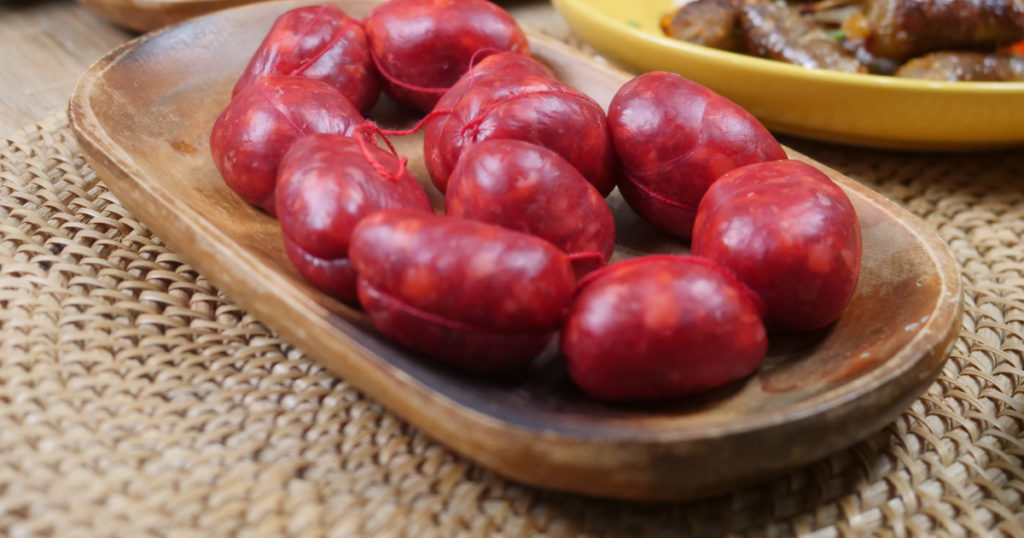
Chorizo de Cebu, also known as longganisa de Cebu, is a beloved pork sausage from the Cebu region. You’ll know it by its sweet, spicy, and garlicky flavor profile. This longganisa hamonado-type stands out with its vibrant red color from achuete seeds and distinctive spherical shape.
Made from a mix of lean pork, pork fat, salt, pepper, sugar, anise liqueur, paprika, garlic, and chilis, it’s encased in hog casings but can also be prepared without them. You typically enjoy this Filipino fried or grilled alongside white or garlic rice, or with puso—a traditional rice wrapped in palm leaves. It’s a versatile and flavorful addition to any Filipino breakfast table.
Longganisa Pinoy Variety 2: Longganisa ng Lucban
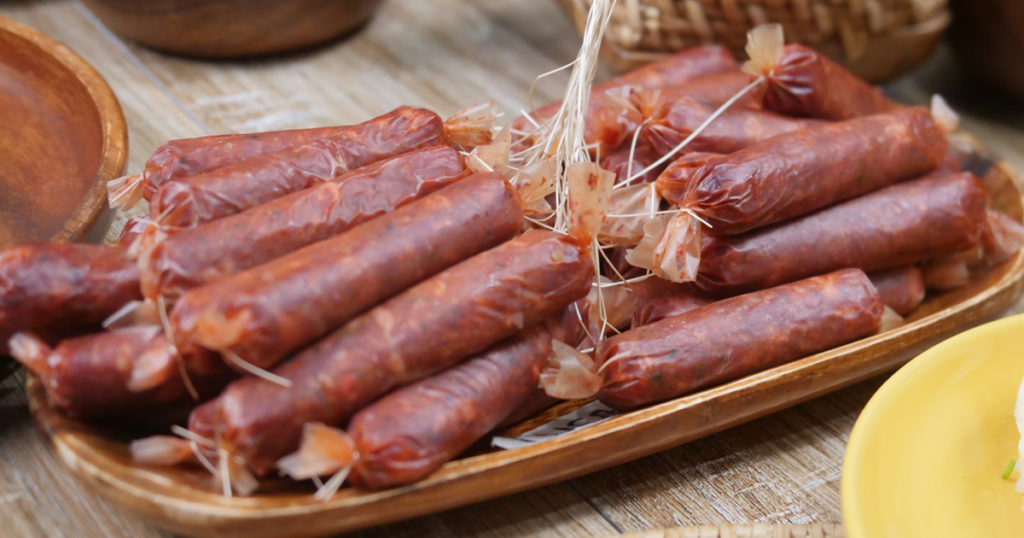
Longganisa ng Lucban is a distinctive Filipino sausage from the town of Lucban in Quezon province, celebrated for its unique garlicky and sour profile. Unlike the more common sweet varieties of longganisa, makers infuse this Filipino longganisa dish with a blend of Mediterranean spices like oregano and smoked paprika, alongside a generous amount of garlic and vinegar.
Aside from the ingredients mentioned above, you usually make this with lean pork, pork fat, coarse salt, sugar, and vinegar, and wrap it in a thick casing, although it can also be enjoyed without the casing. Traditionally served with fried rice and atchara (a Filipino pickled dish), it pairs exceptionally well with Pancit Habhab, another noodle dish that originated from the Quezon province. This sausage’s preparation involves curing the meat mixture in casings, highlighting its robust flavor that’s best savored as a hearty breakfast or a savory snack.
Longganisa Pinoy Variety 3: Vigan Longganisa
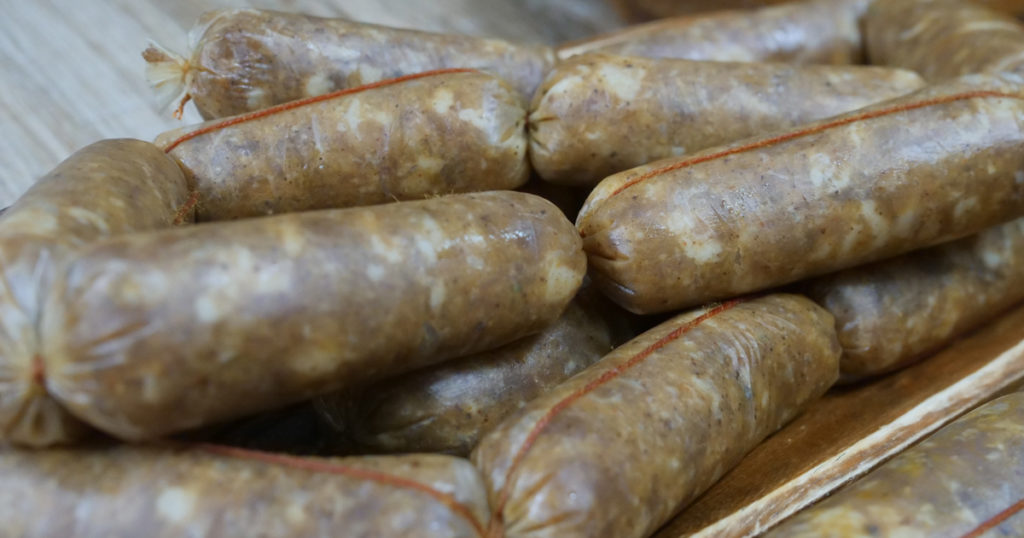
Vigan Longganisa originates from the Ilocos region. When you make them, you hang the sausages under direct sunlight for 4-6 hours to drip dry the fat and excess liquid, then pan-fry them until brown. This method, akin to the traditional smoking over an earthen stove, imbues the Vigan longganisa with a distinct smoky flavor, enhancing its sourness.
Eat it with Ilocos vinegar for an added zing. Have it for breakfast with some garlic rice, tomatoes, and a fried egg for a savory and tangy start to the day!
Longganisa Pinoy Variety 4: Alaminos Longganisa
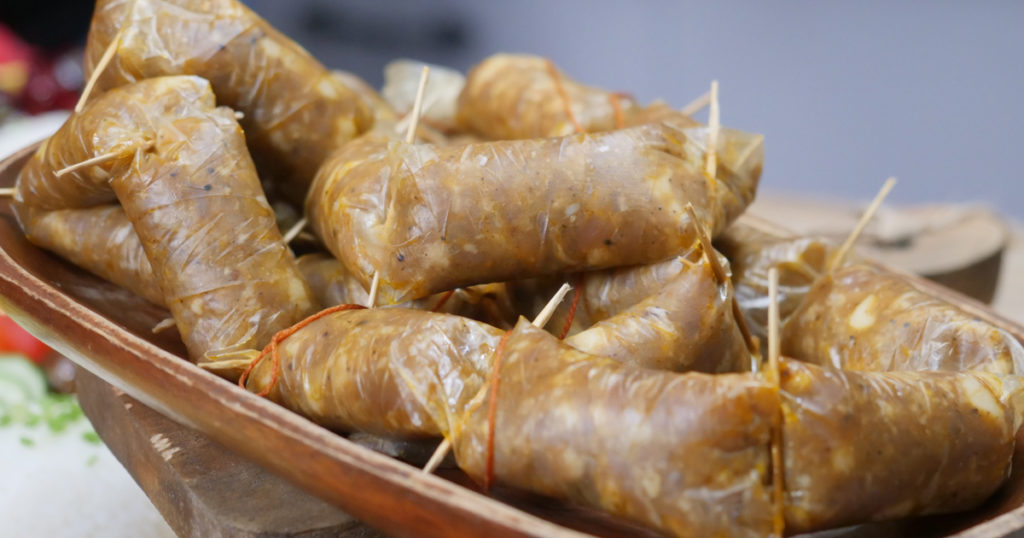
Alaminos Longganisa hails from Pangasinan. It is the perfect little treat for anyone who wants mild flavors and cute, bite-sized portions of food. Aside from it being slightly sweet and having the right touch of garlic, it also has a distinct look.
Instead of the usual twist or string tying these sausages together, makers connect them with little sticks called “buli,” making each string of Alaminos Longganisa look absolutely unique. It’s the kind of detail that adds a dash of fun to your cooking and might even get the kids interested in what’s on their plate.
Oh and a fun fact? Alaminos Longganisa is a star in its own right, celebrated every year at the Longganisa Festival. So, when you bring these Filipino sausages into your kitchen, you’re not just cooking up a meal; you’re whipping up a piece of cultural pride!
Longganisa Pinoy Variety 5: Imus Garlic Longganisa
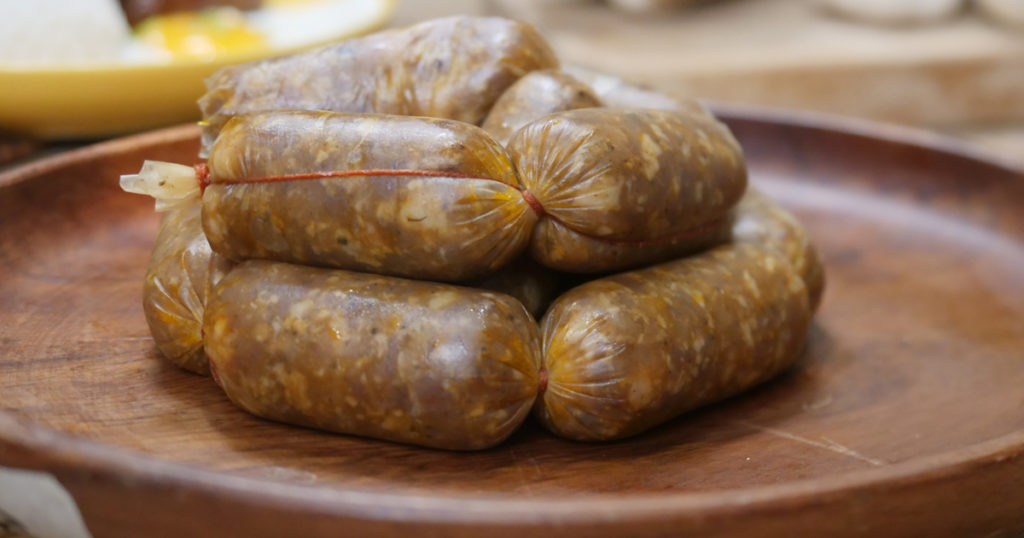
Imus Garlic Longganisa, from Cavite, is one of those Filipino recipes that is a dream come true for garlic enthusiasts. It’s packed with a punch of garlic flavor and has a very bold taste. It’s a recado longganisa, after all. It’s a straightforward recipe that delivers: just combine ground pork, plenty of garlic, soy sauce, vinegar, black pepper, and a touch of achuete seeds for color, and you’re good to go!
You can choose to encase it in hog casing or go for a skinless longganisa variant, depending on your preference.
Longganisa Pinoy Variety 6: Pampanga Hamonado Longganisa
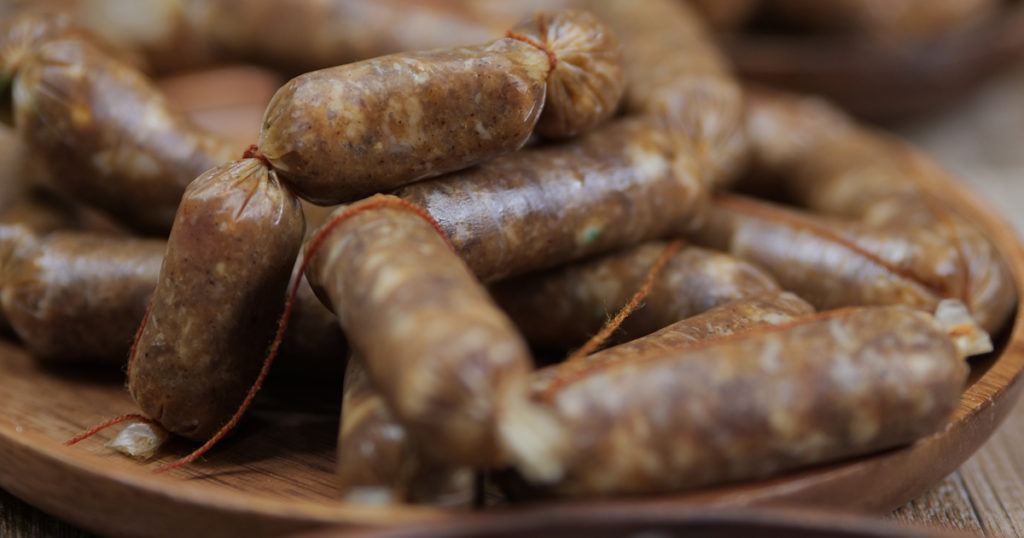
Pampanga Hamonado Longganisa brings a sweet and juicy option to the table. This delightful sausage is known for its rich, hamlike taste that comes from being marinated in pineapple juice. It also has a distinct appearance; while makers often color it orange or red with achuete seeds or annatto powder, the usual longganisa look, this longganisa variant is typically longer and thinner.
Unlike other Philippine sausages that may lean towards the garlicky or spicy, Hamonado is a Filipino sweet sausage, making it a hit for those who prefer this flavor for breakfast. The mixture of ground pork, garlic, brown sugar, black pepper, coarse salt, and a hint of vinegar creates a flavor profile that’s both comforting and satisfying.
Longganisa Pinoy Variety 7: Calumpit Longganisa

Calumpit Longganisa, hailing from Bulacan, Philippines, is known locally as longganisang bawang. This other recado variety in this list is crafted from a mix of lean ground pork, pork fat, and a generous helping of garlic, along with bay leaves, brown sugar, soy sauce, vinegar, salt, and black pepper. Typically, you boil this Filipino longanisa before frying it to achieve the perfect level of doneness, allowing its flavors to fully develop.
Calumpit Longganisa comes in original garlic, spicy garlic, and sweet and spicy varieties. The flavors cater to different tastes – whether you want something traditional or spicy to start your day. With its garlicky profile and touch of sweetness or heat, Calumpit Longganisa offers delicious options to actively customize your experience.
Want to learn a Pinoy longganisa recipe?
Want to start making your own longganisa after reading all about it? Looking to try the diverse longganisa varieties?
Well, you don’t have to go far. Just enroll in Chef Chona Garcia-Laureta’s latest class here at The Bailiwick Academy: Philippines’ Regional Longganisa!
It’s an easy-to-follow class, perfect even if you’re a beginner at making these. And at the end, not only will you be able to make a delicious longganisa Filipino breakfast, you might find yourself posting Filipino longganisa for sale in your social media accounts.
After all, who wouldn’t be attracted to not having to travel to taste their favorite longganisa variants, right? It makes for a pretty good food business!
So what are you waiting for? Sign up at The Bailiwick Academy and start your journey to being one of—if not the best longganisa supplier—in the Philippines and all over the world, today!
—
Keep coming back to The Bailiwick Academy blog for more baking and cooking tips, kitchen tricks, and much more!
]]>In short, the answer to the question “Is canned corned beef good?” is simply yes. This canned meat has definitely made its mark in the Philippines.
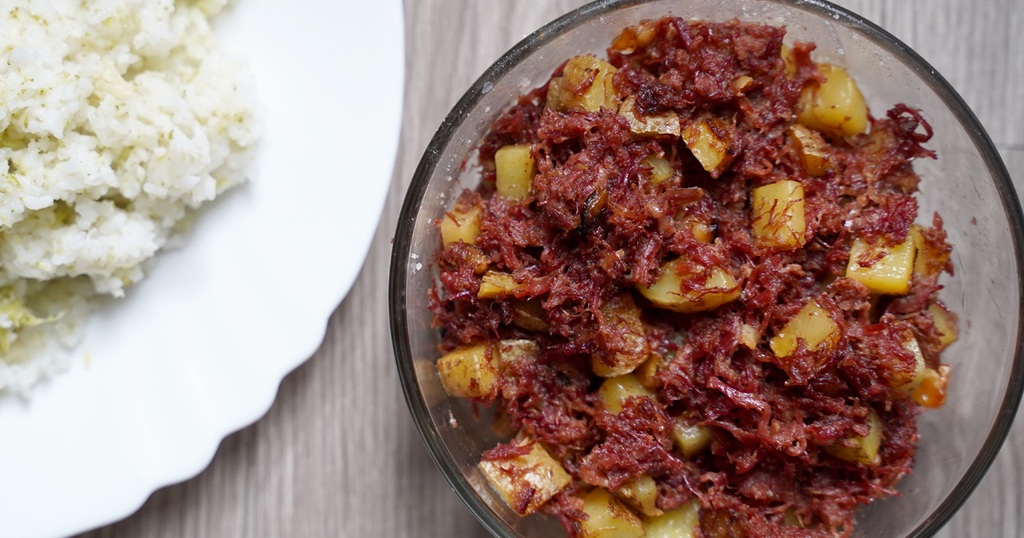
There are many different brands in the market, but what is the best canned corned beef? And by the best, we mean the best-tasting one. To spare you the trouble of answering this question, we got seven brands from the grocery to try.
Why only seven, you ask? Well, for two reasons. One, it was honestly a super random selection, and two, we spotted only these canned beef brands. It’s that simple.
Let’s get to it, shall we?
*Note: This was originally published last June 10, 2021. It has been updated and published on November 5, 2023. Therefore, some brands listed here may no longer exist. Also, prices may be higher or lower than what we published here.
What is corned beef, and why is it popular in the Philippines?
What is corned beef in can? Or, as a more basic question, what is corned beef? So food news flash, it’s not “corn beef”, it’s “corned beef”. The corn part refers to the large grains or “corns” of rock salt used to cure the beef.
The corns of rock salt are probably why corned beef is also known as beef salt or salt beef.
Corned beef became popular in the Philippines during World War 2, a theory according to this blog. American soldiers gave out their corned beef rations. Because Philippine meat is usually hard, the softness of the corned beef made it popular.
It being in cans and being easily transportable was also a factor. And, of course, the beef is imported, and we all know Filipinos love imported stuff.
How did we judge the corned beef in can brands?
Now that you know some trivia about the Filipino canned corned beef preference, let’s go to the taste test.
For this taste test, we kept it simple: we just based it on the taste of each brand. We didn’t use any fancy cooking style, and we did not use an air fryer or instant pot. We just fried each brand in a pan to heat it up.
And if you’re wondering, “Is corned beef in a can already cooked?” the answer is yes. We just like to eat hot food.
To avoid any biases, we didn’t eat any of the brands with bread, pasta, rice, onion, garlic, or cabbage. We didn’t use any salt and pepper, bell pepper, black pepper, or any other additional flavoring. Our basis was simply the taste of each one.
We did not take photos of each product out of the can because, aside from some color differences, corned beef has the same general appearance. And again, since we just judged based on taste alone, the look wasn’t really important to us, although we will comment on the packaging. But that doesn’t affect the final output.
Finally, we were not paid by any brand to conduct this test… although we’re open to sponsors in the future, for sure!
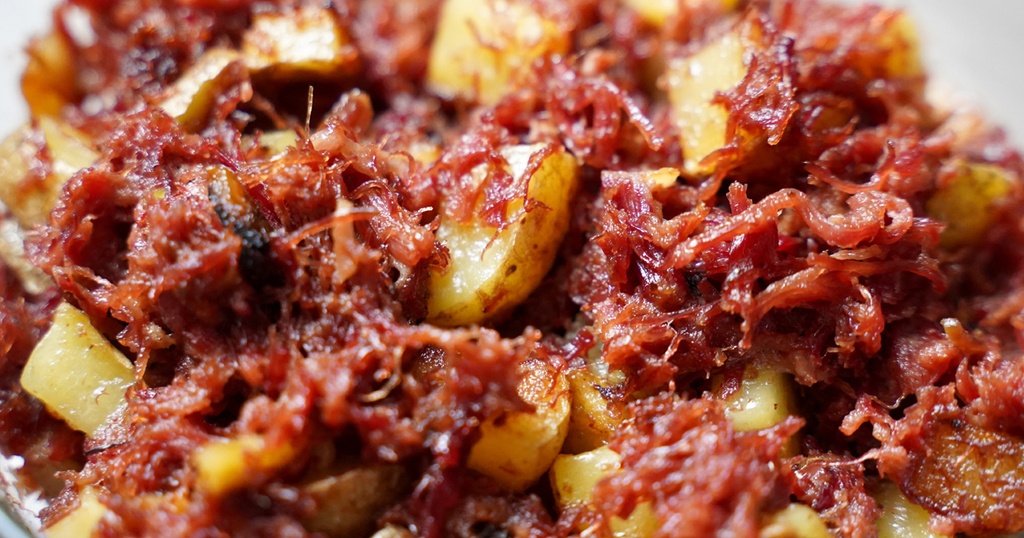
Without further ado, here are our taste test results!
The different corned beef in can brands
1. Argentina
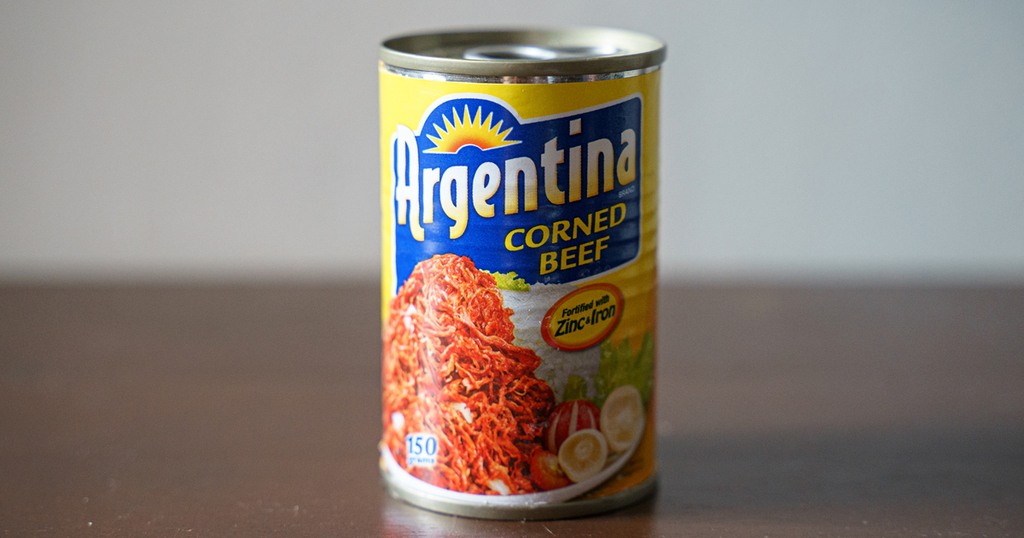
Price – Php32; Weight – 150g
For us, Argentina has the most brand recall among the brands here. We don’t know why. Maybe it’s because of that song by Madonna.
However, it also has the bad luck of its label looking almost like the Star brand (which we will get to later), with both having yellow stickers. That means unless you’re looking for this particular brand, it won’t stand out immediately.
Now, as for the taste… Well, upon taking a bite, we immediately tasted the saltiness of this brand. It wasn’t really unpleasant, but it would have been better if there was more meat instead of salt. How the makers cured it is probably the reason for its saltiness.
Whatever the reason, we found it unbearable to eat on its own. We would have probably been able to finish it if we ate this brand with vegetables, rice, or bread. Anything that would have offset the saltiness, to be honest.
2. Palm
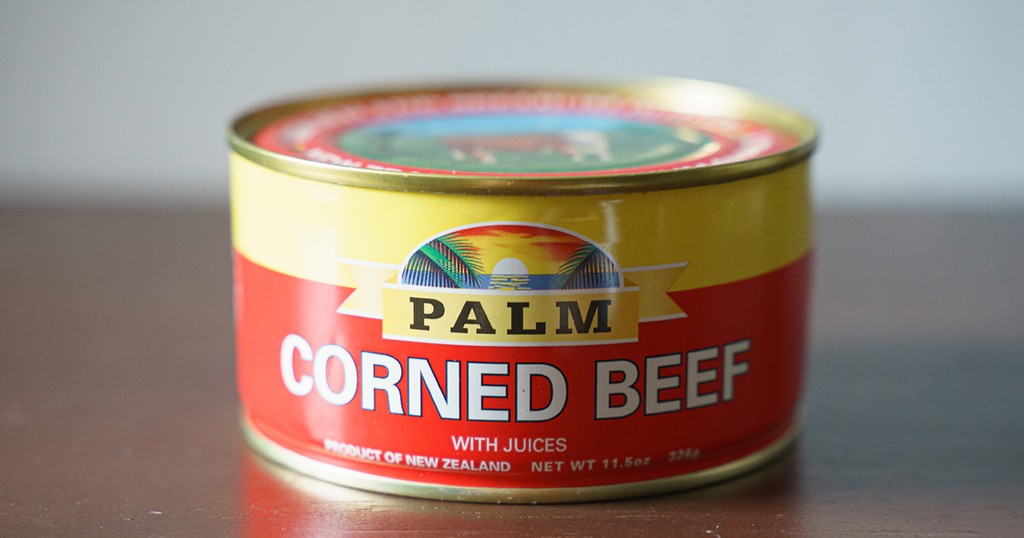
Price – Php219; Weight – 326g
Palm canned corned beef definitely scored some uniqueness points with us right away. While all the other brands are in tall, cylindrical cans, Palm is in a flatter cylinder. It also caught our attention with the weird weight (really, 326? Not 325 or 330?) and the most expensive price out of all the other brands we bought.
What did it taste like? Well, Palm corned beef is less salty compared to the other brands we tasted. It’s kind of bland, in fact-totally different from Argentina.
Of course, if you’re the kind of person who doesn’t like their beef bland, you might not be a fan of this. It’s also a bit juicier than the other brands. If you don’t like that part, just heat up the beef until it becomes crunchy.
3. Swift Premium
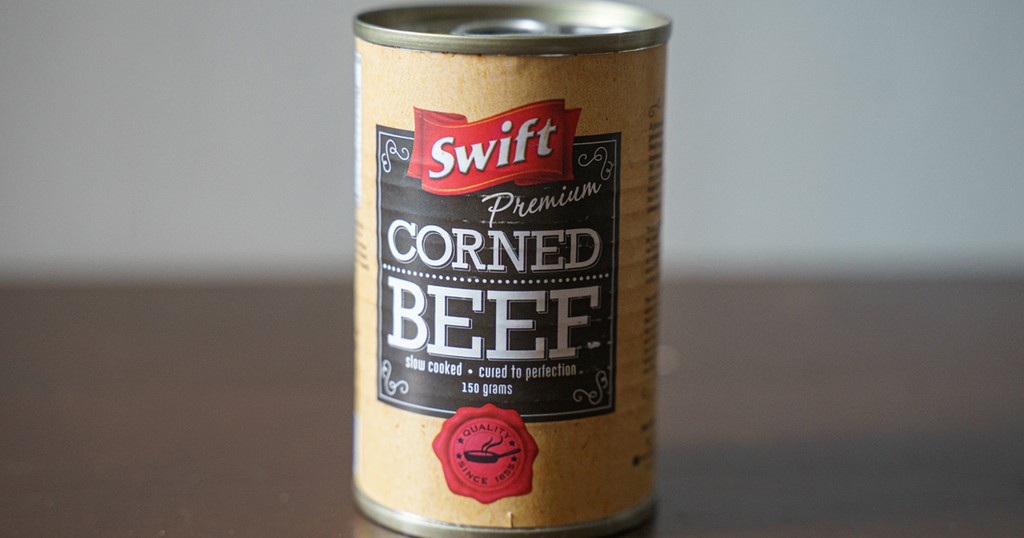
Price – Php74; Weight: 150g
The packaging of Swift definitely caught our eye. It was definitely different from all the others with its nice and warm design. We felt that we would taste something good, thanks to the label design.
And when it came to the eating portion, Swift is indeed actually pretty good. It’s flavorful without being overwhelming. The price and weight also give it awesome value for money.
However, we wouldn’t exactly call it premium. It’s good, and the meat is pretty good quality, but it just lacks that certain something when it comes to taste. We can’t quite put our finger on it. But it’s definitely worth a try.
4. Delimondo
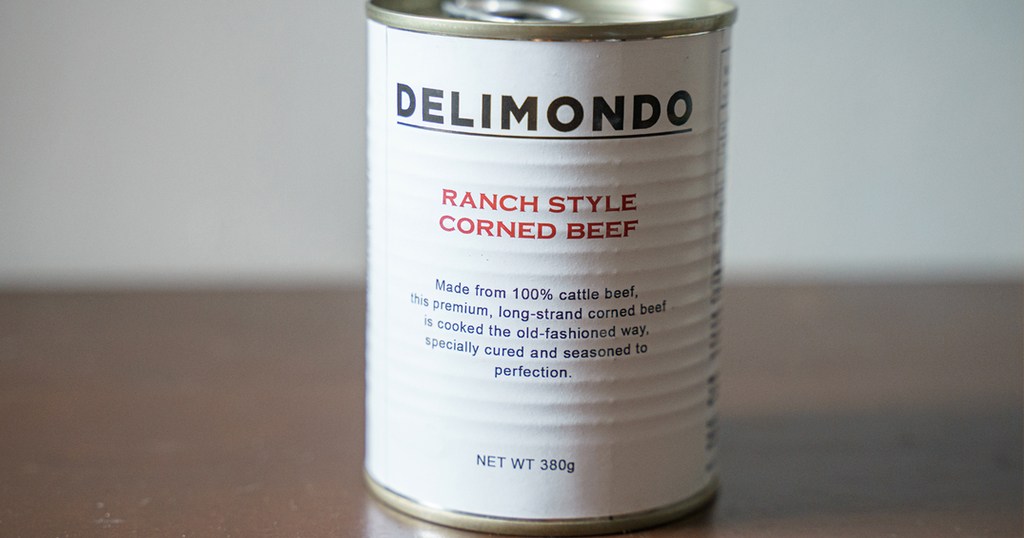
Price – Php179; Weight – 380g
We associate Delimondo with two things: corned beef, white can. The simple and minimalist packaging of this corned beef in can belies the amazing taste! It’s the most flavorful of the bunch in this taste test.
No offense to any of the other brands here, but you can just taste how premium this brand is. The can is fully packed with meat. It also doesn’t feel scrimped-the delicious meat definitely justifies the price.
You know our one true regret when it came to this corned beef in can brand? It was that we finished the whole can because it left us wanting more. It was that good.
If it’s in your grocery budget to splurge, we can definitely recommend splurging on this brand. Buy a can… or even two!
5. Star
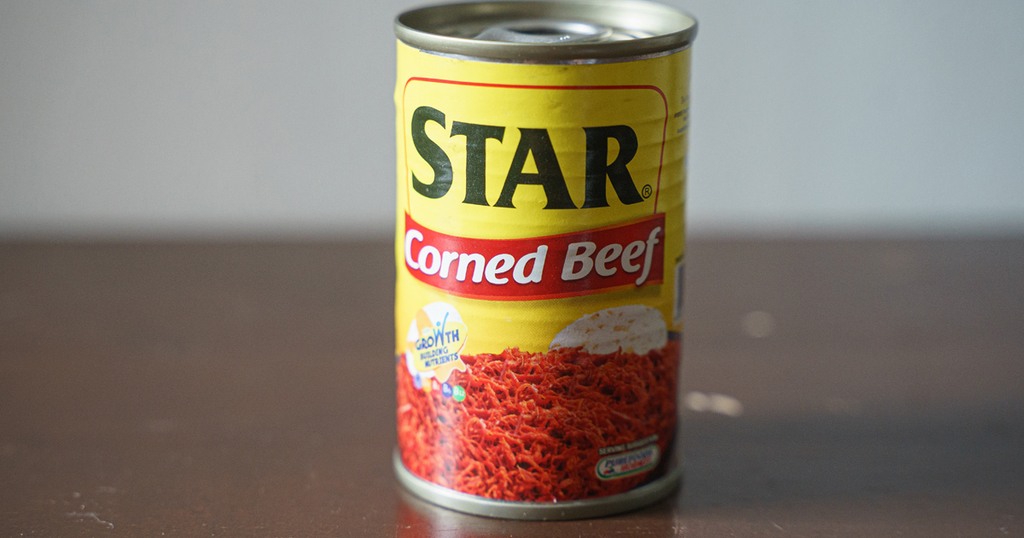
Price – Php30; Weight – 150g
As we already mentioned, Argentina and Star have similar-looking labels. Star just has a more solid yellow one. And just like Argentina, Star has a very good brand recall.
Anyone here who hasn’t encountered Star Margarine and its commercials back in the day? We didn’t think so.
Just like the margarine brand, this corned beef supposedly has health benefits. We don’t know about health benefits, but we do know that again, just like Argentina, it’s also very salty. As in we would have preferred to also eat it with anything that would make us forget about its saltiness.
Maybe it would be a hit with other people who like salty food, but it definitely was not for us.
6. Cattle Co.
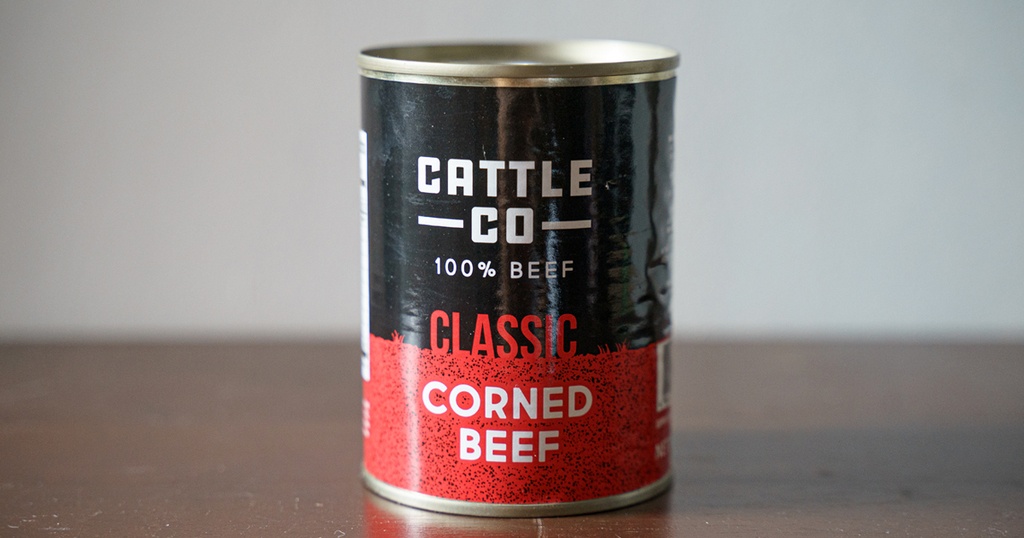
Price – Php165; Weight- 380g
This is one we would say that would be directly competing against Delimondo. It’s actually a pretty new brand to us. This is a brand we have not seen before.
The corned beef, red can slash black can… The packaging alone says that it’s premium. We were expecting a taste that was quite like Delimondo, and we were not disappointed. It also has a great flavor, and the can was also full of genuine meat.
However, the flavor was not like the level of Delimondo. Think of it this way: If Delimondo’s taste was level 5, Cattle Co. was only level 4. The margin is that narrow, though!
It’s definitely a must-try, for sure!
7. Purefoods
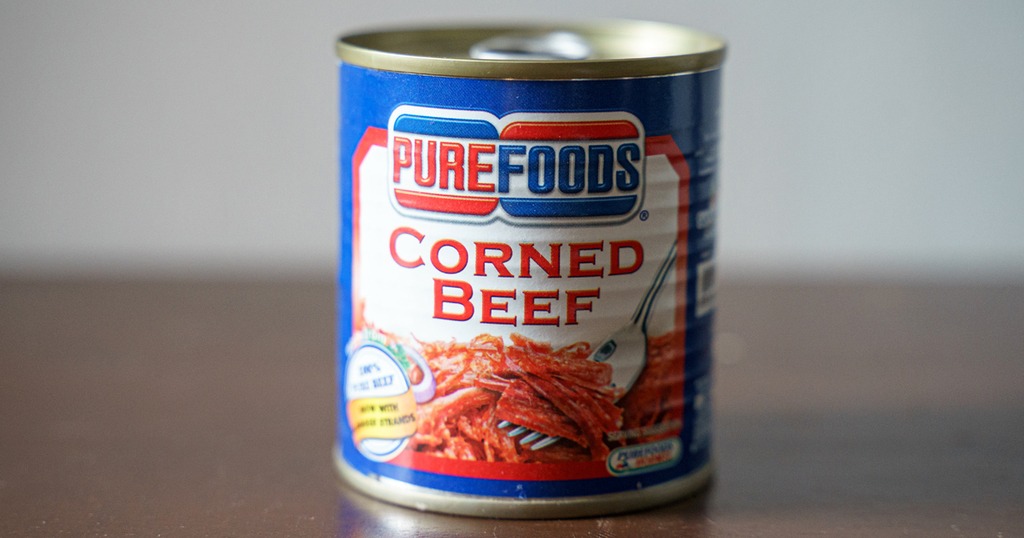
Price – Php71; Weight – 150g
Purefoods is a popular brand in the Philippines and is definitely a classic favorite. If you happened to be searching for recipes using corned beef in a can, we can bet that for most of your life, you would have been using Purefoods.
Just like Swift, the taste is definitely not bad. We think it’s definitely one of the more delicious ones we tasted. It’s a good mix of saltiness and good-tasting meat.
However, also like Swift, there’s just something that prevents it from being premium. It definitely wins in the nostalgia department, though.
Which corned beef in can reigned supreme?
As with all competitions, there can be only one winner. And after tasting all of them, we conclude that the best canned corned beef is… Delimondo.
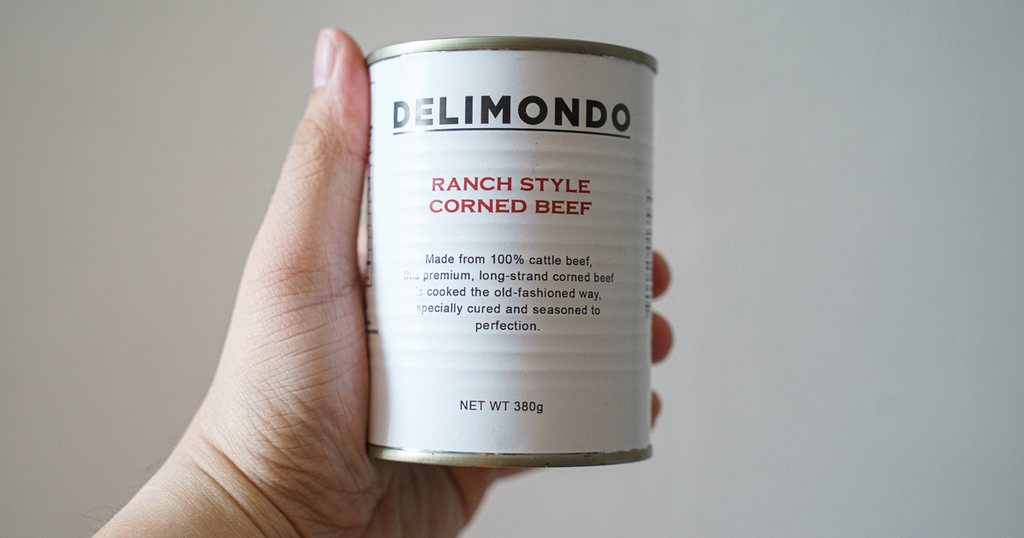
One conclusion we can make is that the pricing directly corresponds with the taste – at least, in this case. We did not deem Palm the winner because its taste was blander than that of Delimondo’s. It’s also actually more expensive and has a smaller amount of grams.
But anyway, we do understand that not everyone is willing to pay a higher amount for canned corned beef. If you do want some good-tasting corned beef in a can with just the right price, we recommend either Purefoods or Swift.
Of course, if you’re not a fan of canned meat, we have an all-natural meat processing class for you. Orrr…
Want to cook your own corned beef at home?
If the current options fall short or you crave corned beef often, consider keeping a steady supply at home. And to make some of the best corned beef you’ve ever tasted, you can enroll in Sir Rodney Martinez’ Soups and Sandwiches online class!
Did you catch a glimpse of the super chunky corned beef sandwich in the teaser? Well, plenty of Bailiwickers have been making that for breakfast, and let us tell you, they and their families are more than satisfied!
In this class, you’ll learn Sir Rodney’s cooking style for making corned beef and, as seen in the trailer, also some easy soup and sandwich combos that both your loved ones and clients will appreciate! But since we are highlighting corned beef here, let us tell you: you’ll always know the answer to the question, “What to do with corned beef?” after this course!
So what are you waiting for? Sign up at The Bailiwick Academy today, start making delicious corned beef, and say goodbye to having to cook canned corned beef ever again! Well, unless you still want to, of course.
—
Keep coming back to The Bailiwick Academy blog for more baking and cooking tips, kitchen tricks, and much more!
]]>Yes, all creams are made from milk fat—yes, another use for milk aside from pouring into your coffee or enhancing your cereal. And yes, all cream can make food taste richer and creamier, and all kinds are called cream. But knowing about different creams is important because it lets you choose the right one for your recipe, helping you get the best taste and texture and avoid wasting food and money.
In this article, I’ll help you do exactly that. Join me as I take a different look at different types of cream available for your use, each with its own texture, fat content, and use. You’ll find out how each one can make your culinary creations better!
Note: This article was originally written last March 18, 2018. This has been updated on September 24, 2023.
How are different types of cream made?
As mentioned above, cream is derived from milk, making any type of cream a dairy product. When fresh milk is left to stand, a layer of cream rises to the top, and this cream is then skimmed off. In modern dairies, this process is expedited using centrifuges called separators.
Do take note that the above is a general overview since different creams require different processes. For example, some commercial creams undergo ultra-pasteurization for longer shelf lives, while some creams are homogenized to ensure a uniform texture and prevent the fat from separating.
The cream obtained after the process can be of varying fat contents, which are then categorized into different types of cream.
Now we get to the heart of the article: what ARE the different types of cream?
Heavy Cream
Heavy cream, also known as whipping cream or heavy whipping cream, has more fat compared to other creams, with at least 36% fat. This makes it great for whipping as it holds its shape well. It’s often used to add richness to desserts, toppings, and fillings because of its creamy texture and taste—but because it’s so rich, it can form lumps more easily than lighter creams.
TL;DR:
- Fat Content: Typically 36-40%
- Uses: Whipping cream is beloved for making whipped cream for desserts as well as custards, ice cream, sour cream, crème fraîche, and rich soups. Its high-fat content makes it whip up beautifully and can hold its shape—perfect for cake icing or frosting.
- Trivia: Heavy cream whipping results in a doubling of its volume!
Clotted Cream
If you haven’t heard of clotted cream, it’s perfectly normal! After all, it’s in England where it’s more common, usually for their scones and jams. If you thought heavy cream had high-fat content already, clotted cream has the most, with about 55-65%!
Clotted cream has an appearance similar to the whipped butter you might have with pancakes in restaurants—thick and rich. You can use clotted cream in sauces or fudge for a richer texture or spread on top of different desserts.
Want to try making it for yourself and, well, trying it out? You can, but you’ll need plenty of time and patience. Get heavy cream and cook it slowly in the oven to make the water evaporate and leave fat behind.
Take note that it takes about a day to make and cool it. It’s safe to keep for a whole week in the fridge.
TL;DR:
- Fat Content: 55-60%
- Uses: A thick, rich cream with a golden crust on top. It’s a common treat in England, particularly enjoyed with scones and jam.
- Trivia: The cream is “clotted” by heating it slowly in shallow pans.
Crème Fraîche
France is a source of many delicious things to indulge in, such as baguettes, opera cakes, and crème fraîch. Crème fraîch is a French cream with good bacteria, making it thick and taste nutty. While it’s similar to sour cream in some ways, it’s not as sour, so it’s great for baking.
You can use it for topping sweet foods such as cobblers or fruit pies—its unique taste adds another layer of flavor to the sweet fruits. You can even add crème fraîch to your mashed potatoes, soups, or stews for an added tang.
TL;DR:
- Fat Content: Around 30-40%
- Uses: This tangy, thickened cream does not curdle at high temperatures, making it perfect for sauces and soups. It’s also delightful on desserts.
- Trivia: It originates from France, and its name literally translates to “fresh cream.”
Light Cream
Light cream has less fat compared to other creams, about 18% to 30% fat. Because it has a lower fat content, it doesn’t whip well, so it’s not ideal for topping desserts. If you plan to use light cream in hot sauces or soups, it’s not the best cream since it might separate due to the heat.
However, light cream is great to add to coffee or drinks for added texture and even flavor. That’s probably why light cream is known as coffee cream or table cream. Light cream also works well in recipes if you want a subtle cream flavor without overpowering the other ingredients.
TL;DR:
- Fat Content: Between 18% and 30%.
- Uses: Commonly used to enrich the flavor of coffees and teas and suitable in recipes that don’t require whipping.
- Trivia: Even though it’s called “light,” it’s still thicker than half-and-half and plain milk!
Double Cream
Double cream is a type of cream made by using a special machine to separate the fat from the milk. As a result, double cream is thicker and richer than heavy cream but with a bit less fat than whipping cream. Speaking of whipping, double cream is great for it but be careful not to overdo it, or it will become butter. It’s perfect for making sauces or risotto thicker and creamier; it has so much fat it won’t curdle easily.
TL;DR:
- Fat Content: About 48%
- Uses: It’s so thick it can be spooned out, making it great for topping various desserts. It can also be whipped, although it thickens rapidly and can become butter.
- Trivia: Double cream can be used to make clotted cream.
Single Cream
I know what you’re thinking: if there’s a double cream available, then there must be a single cream also, right? Well, you got that correctly! Single cream is a cream containing around 20% milk fat or even less and is similar to light cream or half-and-half.
Single cream is very versatile; you can pour it over desserts, add it to coffee or tea, and even use it to make sauces and soups smoother and more flavorful without making it too rich or heavy.
TL;DR:
- Fat Content: Around 18%
- Uses: Perfect to pour over desserts or add to coffee.
- Trivia: It’s too light to whip but adds a creamy touch to dishes and beverages.
All-Purpose Cream
Since it’s the start of the Ber months by the time of this writing, you’re probably going to see plenty of all-purpose cream being stocked in groceries and local stores. Hey, it’s an important ingredient for the usual Pinoy Christmas food, right? But what exactly is all-purpose cream?
Well, as the name implies, it’s a versatile type of cream that is suitable for both cooking and whipping. This cream can be used in a variety of dishes like soups, sauces, desserts, and beverages to add richness, creaminess, and flavor. It usually has a fat content around 18-36%, making it a middle-ground option between light cream and heavy cream.
In short, it’s a handy option to have in your pantry as it can fulfill the roles of different types of cream, saving you from having to buy different kinds of products.
TL;DR:
- Fat Content: Varies, typically around 18-36%
- Uses: Known for its versatility, it can be used in cooking, baking, and dessert-making. Used as a thickening component for fruit salads or the milk component for soups, stews and sauces. It’s also great for pastries and more.
- Trivia: It is processed to have a stable consistency, making it suitable for various culinary applications.
Whipping Cream
Whipping cream and heavy cream are often confused due to their similarities, but they do have some differences. The former has less fat, and while it whips well, it won’t form as stiff peaks as heavy cream would. It’s commonly used in making desserts like whipped cream and mousses and is also handy in soups, sauces, and gravies.
Be careful not to mix up whipping cream with the canned whipped topping found in the frozen aisle, as this is a different product made from a cream substitute and is not ideal for baking or cooking if you’re aiming for the best flavors.
In essence, aside from the slight variations in texture and fat content, whipping cream and heavy cream can generally be used interchangeably, explaining why the terms are often used interchangeably.
TL;DR:
- Fat Content: Around 30-35%
- Uses: Use this to make whipped cream for topping pies, cakes, and other sweet treats. It’s also good for making a creamy frosting for cupcakes and cakes. You can also add it to soups and sauces for extra creaminess.
- Trivia: Some people interchange this with heavy cream, but they are different from one another. If you whip this too much, just like double cream, it can become butter.
Half-and-Half
You might have first heard about half-and-half at Starbucks; I know I did! It’s a favorite for coffee enthusiasts and often has a spot reserved in their fridges. Half-and-half is made by mixing equal parts of milk and cream and has less fat, around 10.5 to 18%.
Aside from it being a popular choice for coffee lovers, you can use it in various recipes such as clam chowder and creamy pasta dishes. However, you can’t use it to make whipping creams since it doesn’t have enough fat.
TL;DR:
- Fat Content: 10-18% (usually made from half milk and half cream)
- Uses: A popular coffee creamer in the U.S., but is also be used in cooking and baking when a lighter cream is preferred.
- Trivia: You can’t whip half-and-half on its own, but if it’s all you have and you’re in a pinch, you can add a little melted butter to increase the fat content and whip it up.
Sour Cream
Sour cream is a tangy and creamy dairy product made by fermenting regular cream with lactic acid bacteria and has around 20% milk fat. It is a staple for many cuisines and is used in dips, dressings, and as a topping for savory dishes like baked potatoes and tacos. However, sour cream is also a baking ingredient—you can use it to add moisture and tenderness to your baked goods for a more delicious experience.
Remember to keep it cool to avoid it going bad. Here’s an added trick: store your sour cream container upside down in the fridge to reduce the space for bacteria to grow!
TL;DR:
- Fat Content: Around 20%
- Uses: Made by fermenting regular cream with certain kinds of lactic acid bacteria. It’s a staple in many dishes, from dips to baked goods to toppings.
- Trivia: Did you know that sour cream is often used in baking to produce a moist crumb in cakes?
Quick Tips On Using Different Types Of Cream
As you may have noticed, creams come in different thicknesses and fat content, and each one is good for different kinds of dishes. Some are best for pouring, others for whipping, and some can do it all! Here are some easy tips to help you figure out which cream to use:
- When choosing a type of cream, consider the fat content as well s the desired flavor and texture of your dish. This is because the fat in the cream can change the taste and feel of your dish.
- Heavy and whipping cream products are best for whipping and for making dishes that require a rich and creamy texture because they have more fat. More fat means they can get thicker when you whip them, and they can make foods taste richer and creamier.
- Light cream and half-and-half are good for adding creaminess to soups, sauces, and gravies. This is because they can mix well with other liquids and add a nice creamy taste without making the dish too thick or heavy.
- Sour cream and crème fraîche add creaminess and a tart flavor to dishes. Since they are thick and have a sour taste, they add creaminess and a little zing to make your culinary creation taste more interesting and feel smoother.
- Clotted cream is good for adding creaminess and a rich flavor to desserts.
Conclusion
Cream is a delicious and versatile ingredient that can be used to enhance the flavor and texture of many different dishes. With so many different types of cream available, there is sure to be a type of cream that is perfect for your recipe.
I hope the next time you reach for that carton in the refrigerator or supermarket aisle, you’ll know what you’ll get with your cooking and baking creations. Happy, er, creaming!
Oh, and of course, before I go, if you want the chance to try different types of cream for different kinds of dishes, whether sweet or savory, sign up at The Bailiwick Academy! With over a hundred courses, you can learn how to use different creams in your cooking and baking and find out how to make yummy dishes and treats that everyone will love.
See you in one of our classes!
—
Keep coming back to The Bailiwick Academy blog for more kitchen and baking tips, tricks, and much more!
That means to achieve a successful bake, you’re going to have to follow the recipe to a T (it’s one of the basic rules of baking!). And for you to do that, you need to understand certain baking terms.
Feeling scared yet? Not to worry; that’s what this guide is for! Keep reading so you can say goodbye to confusing terms and hello to yummy outcomes!
Common Baking Terms – A
- Aerate: The act of incorporating air into your ingredients baking during the production process to increase volume. An example is the act of sifting flour.
- Aged egg whites: This is the process of separating egg whites from the egg yolks. You’ll then store the whites in a loosely covered container for 1-2 days. This process is normally used for baking French macarons.
- Autolyse: This is the process of mixing flour and water and allowing it to rest. This will help gluten development and makes dough easier to handle.
Common Baking Terms – B
- Bain-marie: A method of cooking delicate items such as custards that involves giving them a hot water bath. This is done to cook the items indirectly.
- Bake: To cook food by surrounding it with dry heat in an oven.
- Beat: The act of mixing ingredients together with a circular up-and-down motion using a spoon, whisk, or mixer with a paddle attachment. This is to incorporate air into the mixture.
- Blend: Mixing two or more ingredients to produce one product.
- Blind baking: This is the process of pre-baking a pie crust or other pastry without the filling. This technique is used when you have a filling that needs little to no cooking.
- Bloom: When referring to yeast, it’s the process of mixing yeast with warm water and sugar to activate it. When referring to chocolate, it’s a grayish coating that can appear on the surface. It can also be used to refer to the process of soaking gelatine in water for a few minutes.
- Brulee: Any food that is sprinkled with sugar and then baked or torched to caramelize the sugar. The result is a sweet and hard crust.
Common Baking Terms – C
- Caramelize: The act of heating sugar to the point where it changes to a brownish color and gets a syrupy consistency.
- Choux pastry: A light pastry dough used in many pastries. Its only ingredients are butter, water, flour, and eggs. You can find this in Chef Jimbo de Panadero’s Making the Perfect Cream Puffs and Eclairs class as well as in Chef Ely Salar’s store.
- Cream or Creaming: To beat ingredients (usually sugar and a form of fat, like butter) until you get a smooth, fluffy, and aerated mixture.
- Crumb: This refers to the internal texture of baked goods.
- Curdling: This is the process of separating a food mixture into its component parts. It is usually achieved by adding a catalyst like yeast. This is very popular in cheese-making.
- Cut In: Incorporating butter into flour using a cutting motion until the consistency is small and granular, resembling sand particles. This is done by two knives used in scissors-like fashion or via a pastry blender. Common for making pastries.
Common Baking Terms – D
- Double Boiler: Refers to using two pans of the same size placed on top of one another with water inside the bottom pan. In baking, this is commonly used in melting chocolate. However, this is a cooking technique for steaming dumplings.
- Dough: A mixture of ingredients like flour, water, and yeast that is used for baking breads, pastries, and other food.
- Drizzle: The act of pouring a thin stream of any kind of liquid into food. Ever heard of drizzling chocolate? That’s what this means.
- Dust or Dusting: Lightly sprinkling or coating the surface of a food or work surface with a dry substance like flour, sugar, or cocoa.
Common Baking Terms – E
- Egg wash: Refers to beaten eggs that are sometimes mixed with another liquid. You then brushed it onto food to give it gloss and color when baked.
- Emulsion/Emulsify: The process of combining oil and water. These two liquids don’t mix well naturally, which is why there’s a need for an emulsifier.
- Extract: A concentrated form of food flavoring, such as vanilla extract.
Common Baking Terms – F
- Ferment or Fermentation: Fermentation is the chemical change happening in food during the baking process. The yeast consumes sugars and releases carbon dioxide, causing the dough to rise.
- Fold or Fold-in: To gently integrate ingredients such as whipped cream or beaten egg whites into another mixture without causing loss of air.
- Frosting: A sweet, creamy glaze made of sugar with a liquid, such as water or milk, with ingredients like butter, egg whites, cream cheese, or flavorings and used to cover or decorate baked goods. Also known as “icing.”
Common Baking Terms – G
- Glaze: To coat food with a shiny liquid, icing, or a jelly before or after the food is cooked. It is applied via brushing or drizzling.
- Gluten: A protein found in wheat that gives strength and elasticity to bread and other baked goods.
- Grease: To rub fat on the surface of a pan or dish to prevent any food from sticking to it.
Common Baking Terms – H
- Hydrate: Adding liquid to a dry ingredient.
- Harden: Not the basketball player! It means chilling a mixture until it solidifies.
Common Baking Terms – I
- Icing: Icing is a term used both for the action of covering a cake and for the covering itself (cake icing). It is also called or known as frosting.
- Incorporate: To mix one ingredient into another until everything is evenly distributed.
- Infuse: Steeping an ingredient in a hot liquid to extract its flavor.
Common Baking Terms – J
- Jelly Roll: A thin sheet of sponge cake spread with jelly or other fillings. It is then rolled up.
Common Baking Terms – K
- Knead or Kneading: Kneading is the process of working dough with the heels of one’s hands using a pressing and folding motion. You do this until the dough becomes elastic and smooth.
- Knock Back: The process of ‘punching down’ the dough after it has risen. This will remove any air bubbles and reduce the dough’s volume.
Since we’re on the letter K, I think it’s appropriate to talk about the kitchen. Specifically, the top 10 kitchen tools you must have as a novice baker. When starting out, you might not have all the equipment you’ll need to crush your first-ever recipe.
But that’s why this guide is here! Avoid “guesstimates” and make your journey into baking an enjoyable one. Download this free guide today!
Now, back to the common terms in baking!
Common Baking Terms – L
- Laminate: To layer pastry with butter to create flaky layers such as for croissants. You can experience this in our Laminated Dough class.
- Leaven: The process of adding a substance to bread dough (and other baked goods) which enables the dough to rise. The substance can be yeast, baking powder, baking soda, or even air.
- Line: To “line your pan” means placing parchment or greaseproof paper on your pan to prevent any sticking.
- Lukewarm: Typically around body temperature (98.6°F / 37°C), used often in baking for liquids that are added to yeast.
Common Baking Terms – M
- Marzipan: This refers to a sweet paste made of ground almonds and sugar. It is often used for cake decorations.
- Mise en place: A French term for getting all your ingredients measured, cut, peeled, sliced, grated, and so on, before you start cooking. This is one of Chef Joey Prats’ favorite concepts to teach.
- Mix: Combining ingredients together using a spoon, spatula, or electric mixer.
Common Baking Terms – N
- No-knead: Refers to dough that is mixed but not kneaded. The gluten is developed through the long, slow rise instead.
- Nut meal: Finely ground nuts. One example is almond meal.
Common Baking Terms – O
- Overmix: This refers to mixing batter or dough more than what is needed in a recipe. This can result in a tough product due to the development of gluten.
- Oven spring: The rapid rise of yeast goods in the oven due to the production and expansion of trapped gasses that is caused by the oven’s heat.
Common Baking Terms – P
- Pasteurized egg whites: The process of pasteurization—sterilization via heat— to kill any bacteria that causes foodborne illnesses. They’re not the easiest to whip but can still be achieved by adding cream of tartar or some lemon juice.
- Piping: This isn’t related to plumbing. This refers to a decorating technique achieved using a decorating bag and using various metal decorating tips. One class where you can experience it in The Bailiwick Academy is the Flowers in Full Bloom class.
- Preheat: A cooking process by setting the oven to the desired temperature before placing the food item inside. This process is especially crucial when you’re working with food with yeast, baking powder and baking soda so that you get the proper rise.
- Proof/Proofing/Prove: This is the final dough-rise step before you bake. Proofing dough involves covering and placing the dough in a cool, dry place—and sometimes, refrigeration—allowing the yeast enough time to interact with the flour to produce CO2 to let the dough rise. This term can also refer to the viability of the yeast by dissolving it in water and mixing sugar in it.
- Punch down: This refers to the release of gasses formed by yeast during the rising process.
Common Baking Terms – Q
- Quenelle: An egg-like shape formed from cream or similar ingredient, often made using two spoons.
- Quick bread: Breads that are quick to make because they don’t require kneading or yeast. Incidentally, we have a class that’s called Quick Breads where you can experience making these!
Common Baking Terms – R
- Ribbon Stage: The ribbon stage is a term in baking that describes the consistency of a mixture, typically of eggs and sugar, that’s been beaten until it’s pale, thick, and smooth. When the mixture falls from a spoon or whisk, it should form “ribbons” that hold their shape briefly on the surface before sinking back in.
- Rolling Boil: When water in an open saucepan reaches boiling point and all of the liquid is moving with bubbles that are continually rising and breaking on the surface.
- Rest: When you let the dough rest, that means you’re letting it sit undisturbed for a period of time. It can also refer to carry-over cooking, when cooked or baked food is removed from a heat source to let the internal temperature rise and let the food continue cooking.
- Rise: The process of the dough increasing in volume due to the production of gasses by the yeast. This creates a light, airy structure.
- Roux: A mixture of fat and flour that is used to thicken sauces.
Common Baking Terms – S
- Scald: Heating a liquid to just below the boiling point.
- Sift or Sieve: Process of passing dry and mostly powdery ingredients like flour, cocoa and sugar through a sieve or mesh screen to aerate and remove lumps.
- Simmer: The act of slowly cooking liquid under low heat until it forms bubbles.
- Soft Peaks: Egg whites or cream that have been whipped to the point at which a peak will bend or slump over to one side.
- Starter: A fermented mixture of water and flour that contains a yeast and bacteria culture. Use this to make sourdough bread.
- Stiff Peaks: The opposite of soft peaks—the whipped egg whites or cream will stand completely erect.
- Stir: Using a spoon or ladle to mix liquid ingredients together in either a circular or figure-eight motion.
- Sweet cream: Cream that is not fermented, in contrast to sour cream or crème fraîche.
Common Baking Terms – T
- Temper or Tempering: The process of slowly adding a hot liquid to eggs or other foods to raise their temperature without causing them to get cooked or to curdle. It is also used to refer to heating chocolate to produce a glossy sheen. It allows the sugar crystals to align together to produce a crunchy texture. You can experience tempering in The Art of Chocolate class!
- Trimming: Trimming is the process of cutting off the edges or excess parts of a baked good. This can be done for aesthetic reasons or for practical reasons such as removing an overcooked edge of a cookie.
- Turn: It is simply to fold the dough over onto itself.
Common Baking Terms – U
- Unsaturated fat: A fat that is liquid at room temperature, such as vegetable oils.
- Unsweetened: A product with no added sugar.
Common Baking Terms – V
- Vanilla: A flavor derived from orchids in the genus Vanilla. It’s one of the most usual baking flavors.
- Volume: The space occupied by an ingredient. It also refers to a measurement method (e.g., 1 cup of flour).
Common Baking Terms – W
- Wash: Coating a food item using egg, water, and milk during the pre-baking process. The term can also apply to glazing or icing the food after the baking process.
- Whip: To aerate liquids and increase the volume using a rotary beater or a whisk.
- Whisk: A kitchen tool made of wire loops that add air as it mixes substances together.
- Whole grain: A term used to refer to anything made with or containing whole, unprocessed grains.
Common Baking Terms – X
- Xanthan gum: A thickener and stabilizer used in many foods, especially gluten-free baked goods. This provides a structure that would otherwise be supplied by gluten. You can see this being used in keto bread.
Common Baking Terms – Y
- Yeast: A type of fungus used in baking that ferments sugars and releases carbon dioxide which causes dough to rise.
- Yolk: The yellow center of an egg. It’s high in fat and protein and used in many baking recipes.
Common Baking Terms – Z
- Zest: Zest is the thin and colored outer skin of a citrus fruit. It is fragrant—due to it being rich in oils—which is why it’s added to baked goods for a rich flavor. You can remove it with a vegetable peeler or a paring knife.
- Zabaglione: An Italian dessert, or sometimes a beverage, made with egg yolks, sugar, and a sweet wine.
Final Thoughts
Baking can be quite intimidating, especially if it’s your first time. Not only will you have to make sure you’re following the recipe, but you’ll run into terms you might be unfamiliar with like “proofing”, “kneading”, or “autolyse”. But don’t be discouraged: every master baker was once a beginner who didn’t know these terms either.
All you need to do is keep going and practicing until even these terms—and the whole baking process—become second nature to you. And if you want an avenue for being able to perfect baking via the best classes taught by some of the best instructors in the Philippines, you don’t have to look anywhere else but The Bailiwick Academy. Not only will you become more familiar with these words, but you’ll soon find yourself applying them in real-life baking scenarios!
So if you’re ready to speak the language of baking fluently—in words and in action—sign up at The Bailiwick Academy today. We’re ready to help you on your baking journey and make it into an experience you’ll enjoy…
One where you’ll look back on fondly when you become the baker you’ve always dreamed of becoming!
See you in one of our classes!
—
Keep coming back to The Bailiwick Academy blog for more kitchen tips, tricks, and much more!
]]>It’s not really a mystery why we Pinoys love Japanese cuisine. As this article puts it, “Filipinos have a natural palate for the sweet and savoury, so it comes as no surprise that Japanese cuisine is popular here.”
And as F&B Report, well, reports, Japanese restaurants are high in demand here in the Philippines. So with many Japanese restaurants and different options for Japanese foods, what are the ones to try for beginners or for those who are about to experience Japanese cuisine for the first time?
Well, keep reading for our tasty recommendations. All of these on the list are best to eat in Japan itself, in our opinion, but the ones you can get here are pretty darn good!
Japanese Food You Must Try: Sushi and Sashimi
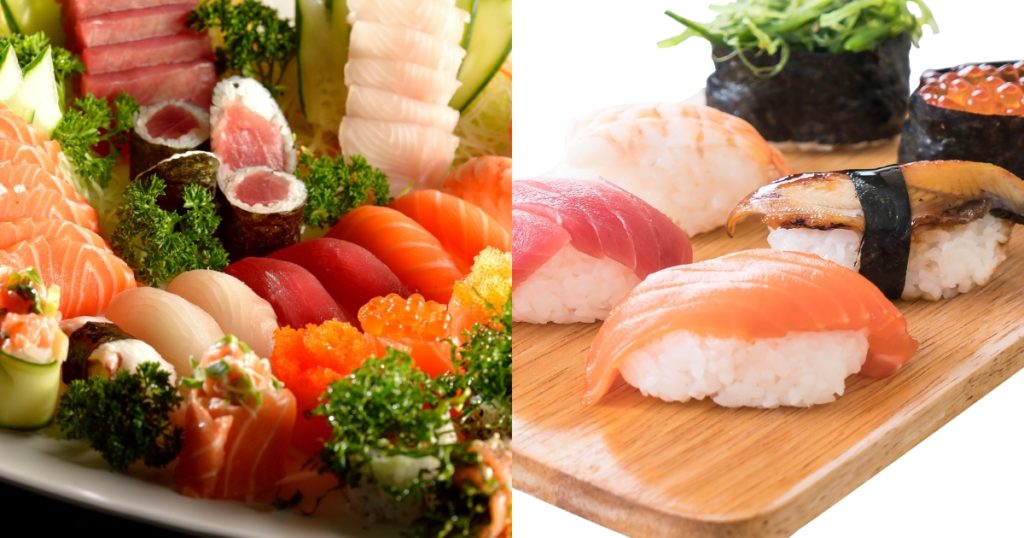
Sushi, the epitome of elegance and precision, is a must-try in the world of Japanese cuisine. Each piece is a work of art, combining vinegared rice with fresh fish or vegetables delicately wrapped in seaweed. The explosion of flavors in every bite will leave you craving for more, no matter the type of sushi you try.
Not far off from sushi is sashimi, another traditional Japanese dish consisting of thinly sliced, fresh, raw seafood. It is typically served without any cooking or seasoning, allowing the natural flavors and textures of the ingredients to shine. Do yourself a favor and look for both every time you step foot in sushi restaurants.
You can also make your own sushi in your own home. Click here to enroll in our Modern Sushi and Maki Class!
Japanese Food You Must Try: Ramen
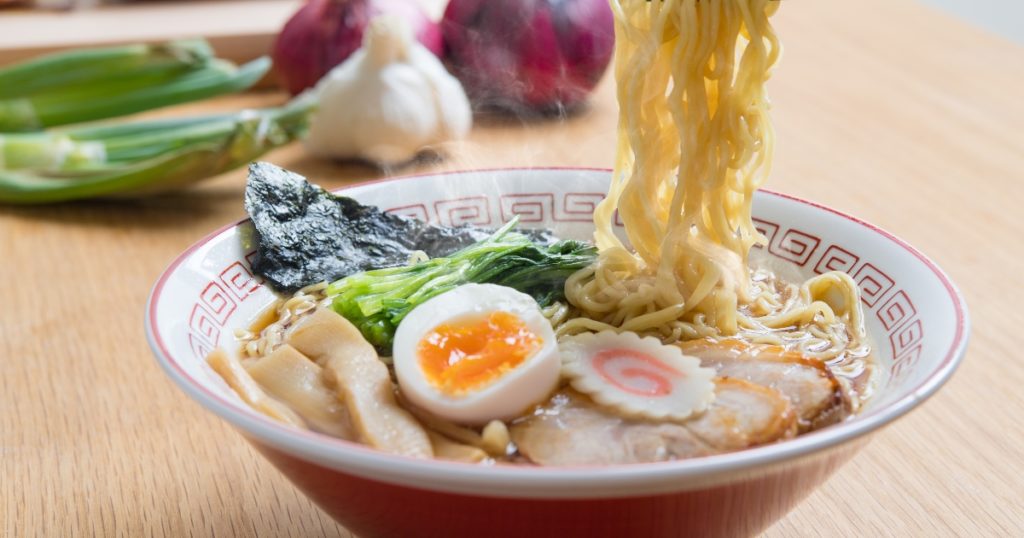
When it comes to Japanese comfort food, there’s nothing better than a bowl of ramen. A steaming bowl of rich broth, noodles, and toppings, such as thin slices of pork or beef, spring onions, and marinated eggs, is one of the things you must try in Japan or in Japanese cuisine. As you slurp the ramen noodle soup, you’ll feel a sense of warmth and contentment wash over you.
It’s a popular Japanese dish for a good reason! You’ll likely want multiple bowls of ramen in one go. And if that’s a yes, it’s probably best for you to enroll in our Ramen Made Easy class! You can make five different kinds at home, just like the ramen in Japan—sounds pretty delicious, agree?
Japanese Food You Should Try: Tempura
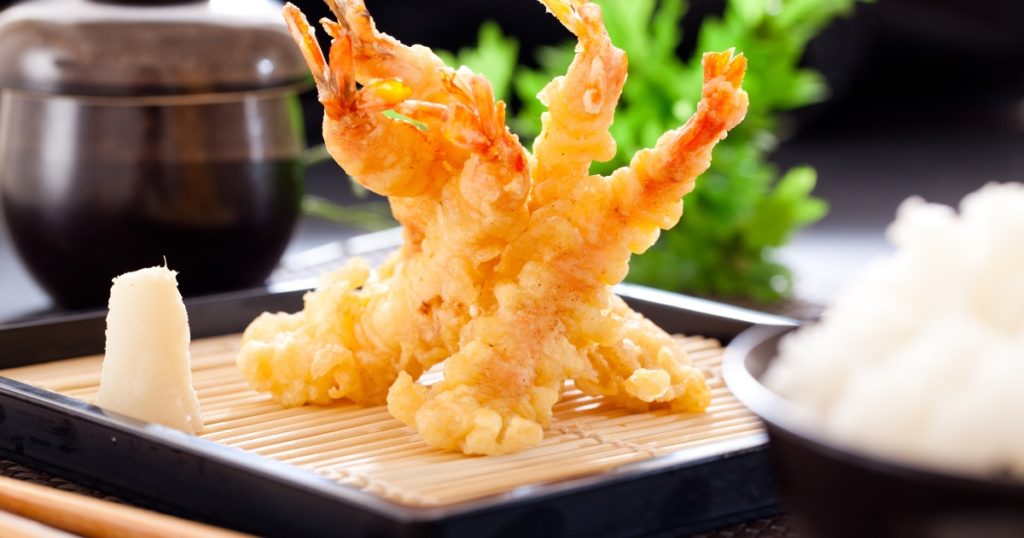
Go to any buffet here in the Philippines that offers tempura, and you’ll find, more often than not, a line for Tempura. That’s how popular this deep fried dish is! In fact, we think that if a tempura restaurant opened here which serves nothing BUT tempura, it would sell out pretty fast!
Well, tempura’s light and crispy batter IS a delightful contrast to the shrimp inside—and don’t forget the dipping sauce! And, of course, since we’re Pinoy, we’d enjoy this with a bowl of rice… or two!
Takoyaki: A Must-Try Dish
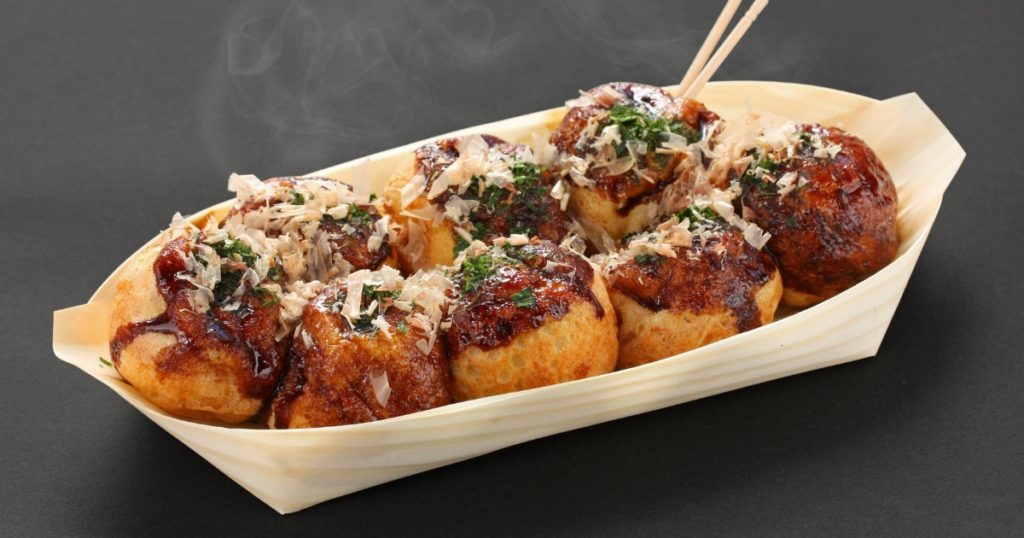
Takoyaki is a popular street food that comes from Osaka. This makes the list because it’s a street food that contains seafood (specifically octopus) and vegetables like green onions and pickled ginger. It’s topped with a special kind of soy sauce and bonito flakes.
Who knew octopus could be made into street food and be so delicious?
You know something else that’s cool? When takoyaki is made hot and fresh, you can see the bonito flakes dance!
And despite it being unusual, eating takoyaki is a joy, especially when you experience the combination of the crispiness outside and the softness and gooeyness on the inside. It’s going to be one of those memorable food experiences for sure!
Onigiri: Portable and Delicious
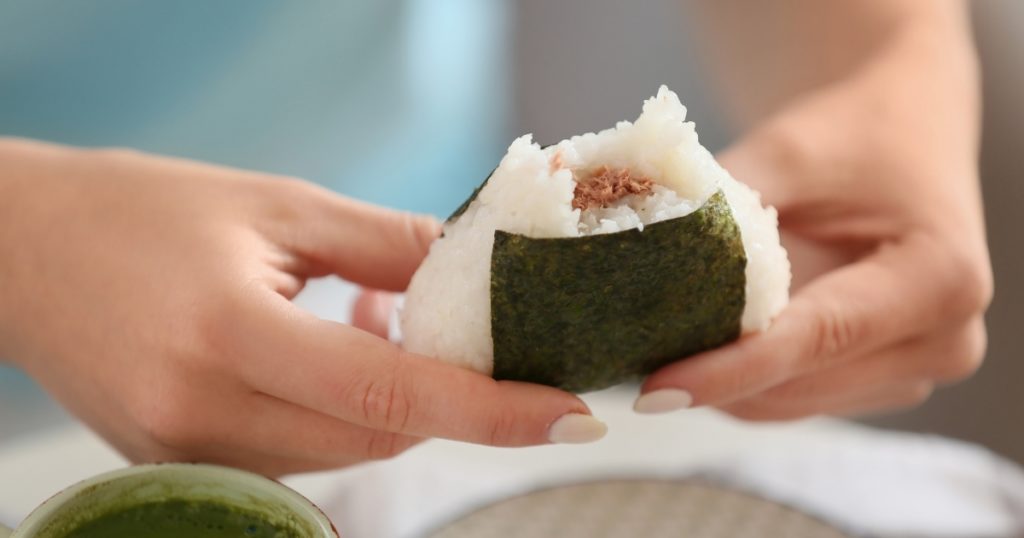
Onigiri, also known as rice balls, are a staple in Japanese cuisine and in Japanese convenience stores. These handheld snacks are made by molding rice into a triangular or cylindrical shape and filling them with ingredients such as pickled plum, salmon, or seasoned seaweed. Onigiri is the perfect snack while you’re on the go, providing a satisfying combination of flavors and textures.
Want to make your own rice ball version? Check out our free Onigiri class!
Japanese Food You Need To Try: Tonkatsu
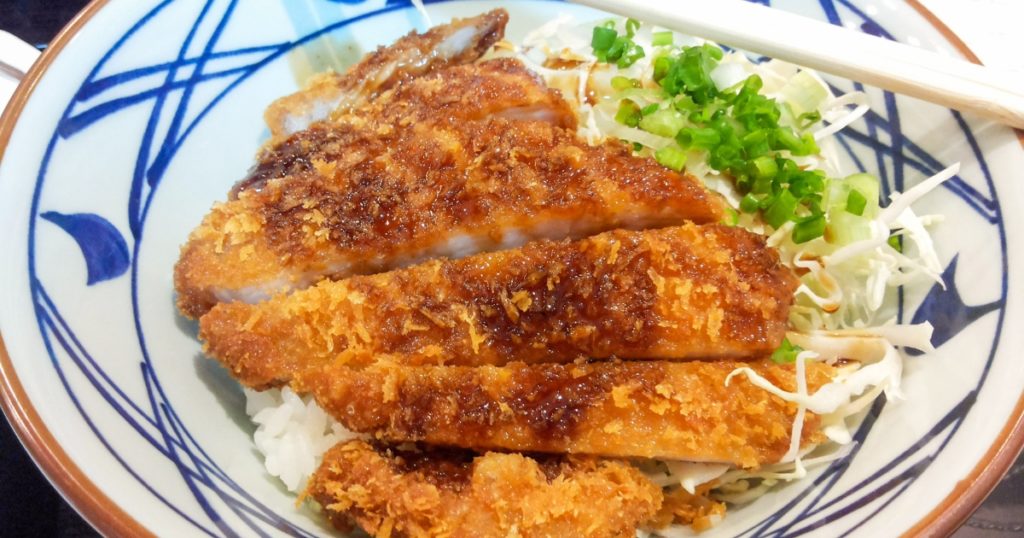
When you say tonkatsu, you’re talking about crispy, breaded, deep-fried pork cutlets. The succulent meat with the breading offers a delightful contrast of textures. It’s served with rice and a tangy dipping sauce, shredded cabbage, and a side of miso soup.
We recommend savoring each pork cutlet you dip into the tonkatsu sauce and eaten with rice. No exaggeration: this is one of the best food in Japan!
Sukiyaki: The Japanese Hot Pot
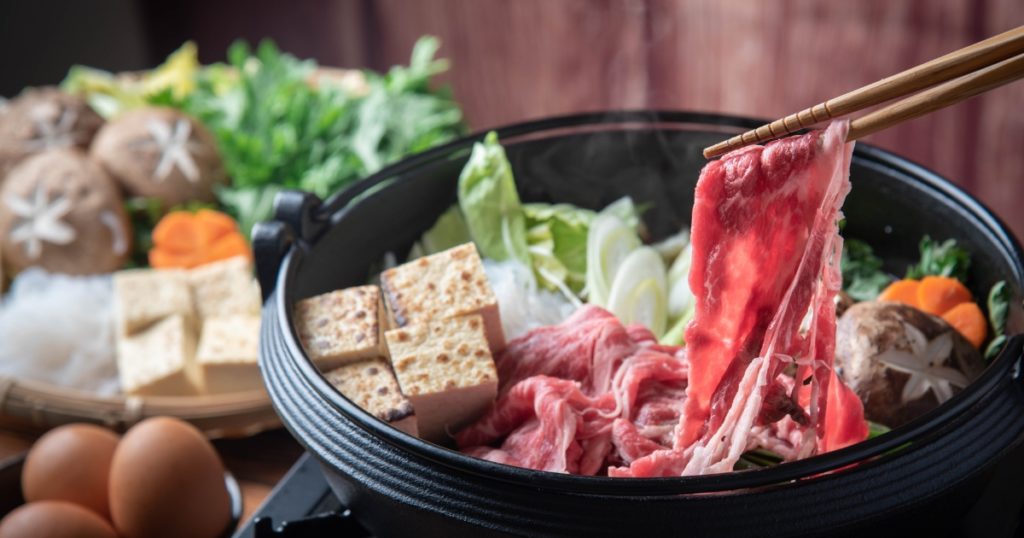
Sukiyaki is a traditional Japanese hot pot dish that, just like ramen, will warm both your body and soul. As of this writing, it’s currently the rainy season in the Philippines, so sukiyaki will be more than appropriate!
Imagine a sweet and savory soy-based broth that contains thinly sliced beef or other meat and vegetables, tofu, and noodles. Sounds good, right? And because the nature of this dish is communal, where the people you’re with gather around the pot, it’s a great bonding experience.
Good traditional Japanese food and people you love—what’s not to like with sukiyaki?
Want a twist on some of these Japanese dishes?
The traditional dishes of Japan are already good by themselves, but did you know you can make them taste even better? At least, that’s if you have the recipes of Chef Him Uy De Baron. Look at how he elevated these famous Japanese foods in his latest cooking class, Easy Japanese!
Discover the next level of these popular Japanese dishes:
- Sukiyaki is a time-honored Japanese hot pot masterpiece. But with this class, you don’t have to do any guesswork in making this. You’ll get the intricate techniques of crafting the perfect Dashi stock, infusing it with tantalizing flavors, and expertly arranging tender beef slices and fresh vegetables in a visually captivating way.
- Do you love tonkatsu? How about cheese? Then you’ll definitely appreciate Chef Him’s Cheesy Mille Feuille, his personal twist on the classic tonkatsu. You’ll get his secrets in achieving flawlessly crispy katsu, as well as how to place melty cheese and aromatic shiso leaves inside so you’ll get a symphony of flavors.
- Chef Him’s Beef Onigiri is not your ordinary kind of rice ball. You’ll get a savory combo of seasoned tender beef on a bed of delicious rice with a robust pepper sauce that gives your onigiri richness and depth. After eating one, you might consider onigiri more than a snack!
And the best part? Whether you’re a beginner or a devoted food enthusiast, this class is tailored to suit your needs and ignite your passion for Japanese cuisine. Unlock the gateway to the authentic flavors of Japan, all within the comfort of your own kitchen—sign up at The Bailiwick Academy today!
Key Takeaways
If you’re looking to explore the world of Japanese cuisine, here’s the scoop: there are a few must-try dishes that will undoubtedly satisfy your taste buds:
- Sushi and sashimi, with their delicate flavors and artful presentation, are an absolute must.
- Ramen, the ultimate comfort food, will warm your soul with its rich broth and delicious toppings.
- Tempura, with its crispy batter and succulent shrimp, is a popular favorite.
- Takoyaki, a delightful street food with octopus, is surprisingly delicious.
- Onigiri, the portable rice balls filled with flavorful ingredients, make for a perfect snack on the go.
- Who can resist the crispy and flavorful tonkatsu served with rice and miso soup?
- Finally, sukiyaki, a communal hot pot dish, is perfect for bonding with loved ones.
And if you’re feeling adventurous and want to take these dishes to the next level, Chef Him Uy De Baron’s cooking class, Easy Japanese, will elevate your culinary experience. So go ahead and dive into the world of Japanese cuisine.
Ultimately, any Japanese food is something you must try—guaranteed!
—
Keep coming back to The Bailiwick Academy blog for more kitchen tips, tricks, and much more!
]]>Read on as we share some low-carb (or even zero-carb) keto-friendly substitutes for some of your usual and favorite eats.
Keto Alternatives for Low-Carb Rice
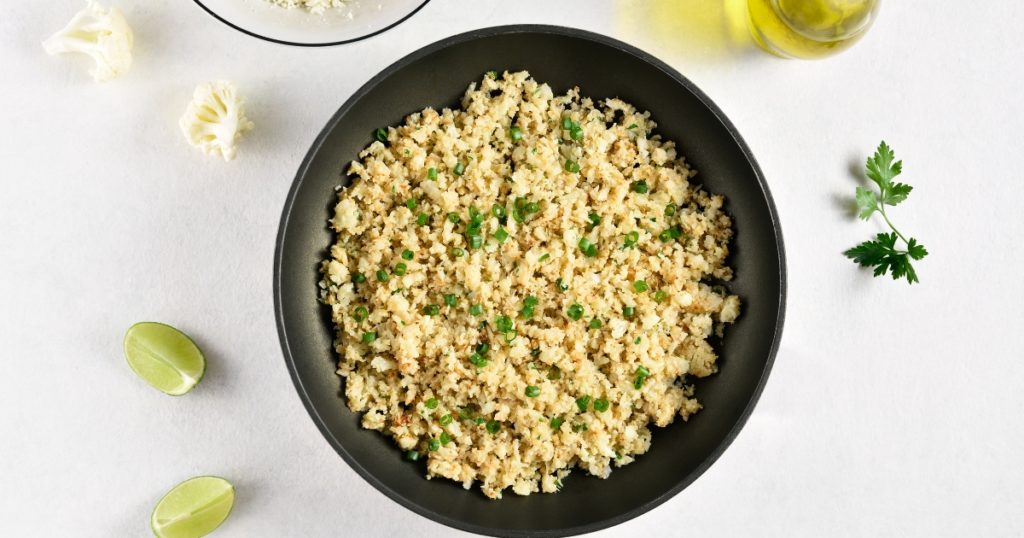
For us Filipinos, rice is life. Hey, we even have various desserts that are basically rice, right? That’s how rice-obsessed we are.
Sadly, rice is not keto-friendly–one cup alone would kick you out of ketosis. But you don’t have to say goodbye to rice, especially if it’s your staple for your meals. Check out some of these keto rice substitutes.
- Broccoli or Cauliflower Rice: Cauliflower and broccoli are both versatile vegetables that can be used in many keto recipes, including as a substitute for rice. Simply chop your chosen vegetable into small pieces and pulse in a food processor until it reaches a rice-like consistency. If you don’t have a food processor, use a grater or chop up the veggie until you get rice-sized pieces. Cook it up in a pan and serve as your keto diet substitute for rice.
- Cabbage Rice: Cabbage is another vegetable option for a rice alternative. It’s low in carbs and easy to prepare. Just shred the cabbage using a knife, a grater, or a chopper. Its slightly sweet flavor goes well with savory food like eggs and meats.
- Shirataki or Konjac Rice: Shirataki and Konjac are both high-fiber, low-carb and very low-calorie rice substitutes. They’re chewy and neutral in flavor, meaning they pair well with any kind of food. You can buy these online; you might see stores selling shirataki noodles, which means you can also have low-carb and low-calorie ramen and other noodle dishes.
It might take some time to get used to these, but we promise: you’ll get to the point of enjoying them.
Keto Substitutes for Bread

If rice is life for Filipinos, bread comes as a close second. After all, we have plenty of favorites in Pinoy bakeries and various spreads to enhance our enjoyment. Sadly, since the usual white bread has a high carbohydrate content, it’s another food you have to avoid.
Good thing there’s keto bread–as in keto substitutes for flour bread, such as:
- Coconut Flour Bread: Coconut flour is a low-carb alternative to wheat flour and can be used to make keto-friendly bread. You’ll get bread high in fiber and protein and a natural sweet taste.
- Almond Flour Bread: Almond flour is another low-carb flour that can be used to make keto-friendly bread. Your bread will have a slightly nutty flavor and a dense texture.
- Cloud Bread: Cloud bread went viral because of TikTok. But what is cloud bread, exactly? Well, it’s a light and fluffy bread alternative made from eggs, cream cheese, and cream of tartar. It’s another great low-carb option!
And if you’re looking for exact recipes on how to make keto bread, look no further than our class here at The Bailiwick Academy: Keto Bread The Gluten Free Series! You’ll get to make four kinds of keto bread: Keto Dinner Rolls, Keto Loaf Bread, Keto Burger and Hotdog Buns, and Keto Pan de Sal.
You definitely won’t have to say goodbye to bread!
Keto Substitutes for Various Desserts

Just because you have to do keto doesn’t mean dessert is off-limits for you. There are plenty of low-carb alternatives for desserts, such as:
- Keto Ice Cream: No need to look for a keto substitute for ice cream, as there are already plenty of keto ice cream brands in the market. They come in various flavors, and plenty taste like the real thing. You can even make your own–enroll in our Keto Ice Cream class to get started.
- Keto Cakes: If you need to satisfy your sweet tooth, rejoice, as keto cakes are now included in low-carb foods that are on the market. You no longer have to worry about them being high in sugar and carbs since these cakes are made with keto substitutes that are friendly to your diet. For example, they use almond or coconut flour instead of cake makers using wheat flour. And just like with ice cream, you can get started making Keto Cakes here at The Bailiwick Academy. Choose from Keto Cakes, Keto Cheesecakes, or Keto Cakes 2, and come up with plenty of guilt-free delicious cakes!
You can also indulge in donuts, muffins, brownies (available in our Keto Easy-Bake Bestsellers), and even various Filipino favorites like bibingka and puto bumbong.
Do take note that even though these keto desserts are lower in net carbs than their traditional counterparts, these keto alternatives should still be eaten in moderation since they are generally high in calories and fat. Practice enjoying them as occasional treats.
Zero Carb Drinks

If you like drinking Coke, Pepsi, and any other carbonated drinks, you should be aware by now of their high sugar content. But you don’t have to look far for keto alternatives to soda. You don’t have to get rid of soda entirely, either.
Coke Zero, Coke Light, Sprite Zero, and Pepsi Max are all keto-friendly. They’re zero calories too! The same goes for plenty of other drinks in the market, like Rite N’ Lite.
Of course, make sure to check with your personal doctor how much of these you can safely consume in a day.
Keto Substitutes for Snacks

Like eating fries, potato chips, and other salty snacks? We can’t blame you–they’re delicious and can be quite comforting, especially if you’ve had a very long day. The carb count for these, though, is a different story.
You don’t have to stop snacking though–just exchange your usual high-carb foods with low-carb ones. For example, instead of eating chips, eat chicharon or pork rinds instead. They’re also crunchy and salty, but most importantly, they carry a zero carb count.
You can also eat nuts and seeds instead. You’ll have to read the label and/or do research, but plenty of them have low net carbs. Just be sure to limit your intake to follow your daily carb limit.
One more you can do is use zucchini as a potato substitute. Zucchini has lower carbs and calories compared to potatoes, so you can make zucchini chips or zucchini fries instead. When sliced thinly and baked or fried, zucchini can have a crunchy texture that is similar to potato chips or fries.
Don’t know it until you’ve tried it!
Keto-Friendly Sweeteners
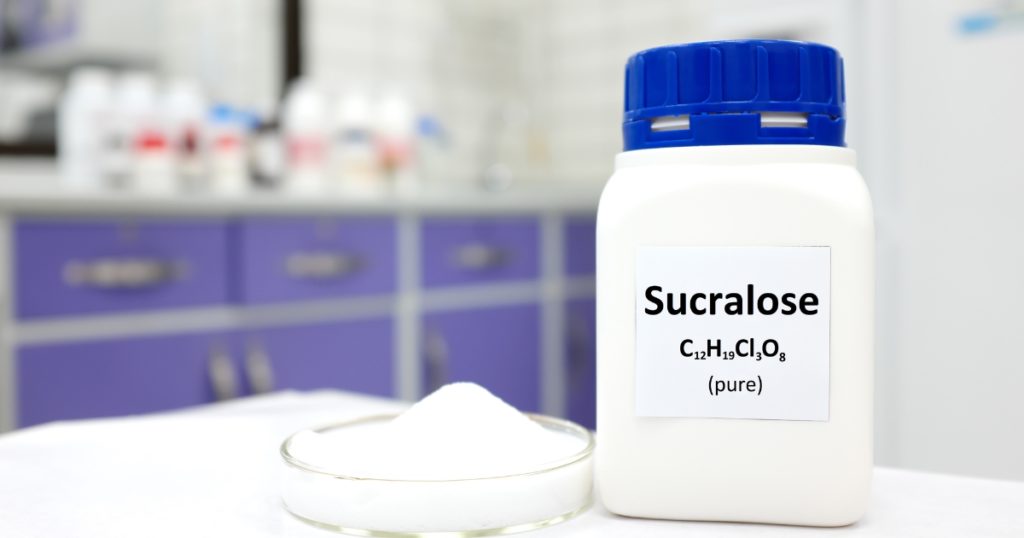
Pinoys use sugar in everything, especially for our morning coffee. But as we already know, sugar is not allowed in keto diets. Use the following substitutes instead:
- Stevia: Stevia is a natural sweetener that is derived from the stevia plant. It has no calories, and some describe it as much sweeter than regular sugar. Stevia is the most-talked-about keto substitute for sugar because it doesn’t impact the levels of different people’s blood sugars.
- Erythritol: Erythritol is a sugar alcohol that is commonly used as a sugar substitute in the keto diet. It has only 0.2 calories per gram and also does not have an impact on blood sugar levels. However, according to Healthline, consuming too much of it may cause digestive issues, including nausea.
- Monk Fruit: Monk fruit is a natural sweetener that is derived from the monk fruit plant. It also has no calories and can be much sweeter than the usual sugar. It does not have an impact on blood sugar levels. You’re more likely to find monk fruit in online stores here than in groceries.
- Sucralose: Sucralose is a no-calorie sweetener that is made by modifying regular sugar molecules to create a new compound that the body does not recognize as sugar. While sucralose is generally considered safe to consume in moderation, some believe that consuming artificial sweeteners like sucralose can cause an insulin response. Research on this topic is mixed and has no official conclusion yet.
Will artificial sweeteners stop ketosis? Some people seem to think so, but there’s no evidence suggesting that keto sugar substitutes will affect ketosis. So until there’s actual evidence, keep on using it.
Keto Substitutes for Pasta

Pasta noodles are again, high in carbohydrates. After all, traditional pasta noodles are made from wheat flour which has 76g of carbs for every 100g. However, you can choose from any keto alternative to pasta that can be used to recreate keto-friendly pasta meals, such as:
- Zucchini Noodles (Zoodles) – Zucchini noodles are made by spiralizing zucchini into thin, noodle-like strips. They have a similar texture to pasta, making this one of the most popular keto diet replacements for pasta.
- Spaghetti Squash – Spaghetti squash is a type of winter squash that can be roasted and shredded to create a pasta-like texture.
- Shirataki Noodles – We’ve mentioned these before, but instead of in rice form, they’re now in noodle form. Like zucchini noodles, they have quite a similar texture to pasta.
Final Thoughts
As you can see, just because you’re on a keto diet, it doesn’t mean you have to give up your favorite foods altogether. There are plenty of delicious and satisfying keto-friendly alternatives out there that can help you stay on track while still enjoying the flavors you love. We hope this list gives you a headstart on looking for those keto substitutes.
In the meantime, we wish you all the best as you go on your keto diet. Here’s to a better and healthier you!
Speaking of Keto Pasta…
If you’re interested in making your own keto pasta–and achieving it in the fastest and best time possible, then you’re in luck. The Bailiwick Academy has a new course by Ms. Chiqui Dingong: Keto Pasta!
Check out the video below to learn more about our latest class:
When you enroll in Keto Pasta, you’ll learn to make low-carb and sugar-free pasta dishes that are just as delicious as the real deal. Not only will you learn to make three kinds of pasta (fettuccine, lasagne, and spaghetti), but you’ll also get recipes for three pasta sauces: Truffle Mushroom Cream Sauce, Ragu ala Bolognese, and Pesto ala Genovese.
And guess what? You’ll be making REAL pasta noodles! No substitutes like shirataki–but you’ll have to enroll in this course to find out how Ms. Chiqui does it!
Satisfy that pasta craving with these delectable pasta dishes without the guilt–and appeal to customers who are looking for keto alternatives, too! Sign up at The Bailiwick Academy today to get started!
Oh, and if you’re reading this now (May 15, 2023, Philippine Time), this new course is on sale until 8:30 PM today! Make sure to grab it before the sale expires!
—
Keep coming back to The Bailiwick Academy blog for more kitchen tips, tricks, and much more!
]]>Well, that’s exactly what we will talk about in this blog.
Key Takeaways
TL;DR? Here’s a quick summary of what to expect from this article:
- When planning a catering menu, it’s important to have a specific target market in mind. Focus on that one market so that you can memorize and perfect their needs, which helps you build a good reputation and gets you similar work.
- Pricing isn’t just about the food–consider also logistics, cost of food, and other business costs.
- Do further research and education to make better business decisions about running a catering events business.
A Quick Disclaimer About This Article
While we will discuss what to consider when planning a catering menu, this isn’t a deep dive into the topic. A food and beverage business or how to plan a catering business needs more consideration and information than just one blog article. So while we can give you some things to consider, we’d also encourage you to learn more for yourself.
For example, one of the courses at The Bailiwick Academy is Branding 101. Another is Bakery Operations. These and other courses might help you with how to create a catering business plan and make better business decisions.
In short, while this is a quick overview, this is not an article that’s an end-all-be-all about planning catering menus. Also, these won’t be in any particular order, but you have to really consider all of these, as these are important for a successful catering menu or business.
Got it? Good.
How To Plan A Catering Menu: Who Do You Want to Serve?
One thing you have to remember is that in business, you have to have a specific target market. You need to decide on who you want to serve primarily. This also applies to having a catering business.
Let’s say you do decide to enter catering. Do you want to serve personal events like weddings, birthdays, and baptisms? Or would you rather look for a catering event for business people weekly? After all, how to plan catering for a wedding differs from how to plan catering for an event in a corporate setting.
The question doesn’t stop there, though. If you decide to serve weddings, would you rather serve high-end weddings? Or would you be happy serving weddings that are budgeted?
Again, the people in these events will be looking for different things. And if you read our feature on Chef Joey Prats, you’d know that he recommends focusing on one product. The same advice counts for the target market: focus on one.
When you focus on one market, you can memorize and perfect their needs and expectations. Doing this will help you build a good reputation and get you more work for similar people. That’s always a good thing, agree?
How To Plan A Catering Menu: Consider The Logistics
Now that you know who you want to serve, the next thing to consider is the logistics, as these will factor into your costs. As we said, you shouldn’t only consider menu items!
Let’s go back to the target market. Say you’ve decided to focus solely on corporate events. Will you accept only certain corporate events, or will you take on all of them?
For example, what if you’re located in Laguna, and a potential client wants to get you for a corporate event in Pampanga? Will you be able to accommodate their request?
Aside from the location, here are some other logistical considerations:
- Staffing – You should determine the number of staff needed, their roles and responsibilities, and their schedules. This includes chefs, servers, bartenders, and event coordinators. Remember, the more you want to give to your clients, the more people you’ll likely need!
- Transportation – Transportation isn’t only considered if, say, you want to run a food truck. After all, if you’re going on location for any type of event, you should be able to transport the food, equipment, and yourself and your team to the venue. You should also determine the truck size you need or if a van will suffice.
- Equipment – If you plan to enter wedding event catering, you should know that you won’t be able to survive on just one kind of chair and decoration. You have to be able to give your possible clients options that will fit their wedding themes. Catering for corporate events is more forgiving, but these clients will still eventually look for options from you. Consider also that catering can come in different forms: buffets, food stations, seated and served, stand-up cocktails, and even outdoor picnics. Do you want to be able to serve all that or just some?
How To Plan A Catering Menu: Pricing
Ever wonder sometimes about the catering cost per person, especially if you feel like it’s too high? Well, here are some factors to consider in how to price a catering menu.
- Cost of ingredients – This is one important factor in pricing. After all, depending on the market you choose to serve and the types of food they want, you could run up a hefty bill just buying the ingredients alone! Of course, you’re going to charge that to the client. Include also if you’ll serve an alcoholic beverage per person, if they have appetizers, and pretty much anything food related.
- Labor costs – You will also have to factor in the salaries of your chefs, servers, and other staff. In the future, if you add more people, even those not necessarily go with actual events, include those too! They do help with your business, after all. You might even have to raise prices to serve people better.
- Your equipment and logistical costs – How much did you buy your equipment, such as chairs, linens, and tools for food safety? How much are your transportation costs? Insurance? Factor those in as well.
- Your markup – All these mentioned above are just your operational and overhead costs. If you don’t add in how much you want to make per event, you’re not going to make money. And you have to–after all, businesses survive because of profits, not because of anything else. You have to make money.
Once you have all these, divide the cost of the event by the number of guests, and that’s where you’ll get the cost per person. It is important to note that the cost per person will vary depending on the menu, the level of service provided, and other factors.
How To Plan A Catering Menu: Planning The Food
Oh, look, we’re finally getting to the food! Why did we place this last? Well, it’s probably the easiest for you, especially if you’ve been making food for a long time already.
After all, you’re reading this because you’re thinking of getting into catering. And that means you already have a preference for your menu, correct?
And it does go back to Chef Joey’s advice about one first. So what kind of food or cuisine do you want to serve? Sure cuisine that will sell is Filipino food, but you can also offer other ones, like Korean and Spanish.
You can even choose to niche down further and offer only keto catering. However, how to plan a keto menu is much more complicated than the usual kinds. That’s something to consider as your price might go up!
Your price will also go up if you want to give clients options to serve their guests who have special dietary restrictions.
But once you’ve decided on the food you plan to serve, that’s when you can get to the nitty-gritty. You can customize courses, make avant-garde versions of the cuisine, and so on. It will really depend on your target market and what would appeal to them.
Final Thoughts
Ready to get started on making your own catered event menu? Just consider all the following that we discussed in this article. Remember to consider who you want to serve and all the costs that you will incur, and make sure you’ll profit! By doing so, you’ll be well on your way to not only building a catering menu that will impress your guests but you’ll also have a successful catering business that will last a long time!
Speaking Of Menu Choices…
If you’ve decided to go with our suggestion of serving Pinoy food to start, The Bailiwick Academy has a class that’d be perfect for you to start: Chef Anthony Ang’s Pinoy Handaan!
In this class, you’ll learn to make three classic Filipino party dishes that are restaurant quality using Chef Anthony’s recipes:
- Pancit Overload
- Crispy Pata
- And the very packed Lumpiang Shanghai!
Whether you’re catering for a wedding, a corporate event, or even a simple occasion at home, you can be sure that these menu options will make for a menu that will impress! That’s especially since this class has simple, clear and easy-to-follow instructions that will let you master the dishes in no time!
So what are you waiting for? Sign up at The Bailiwick Academy today and get started planning your perfect Filipino food menu by enrolling in this class!
—
Keep coming back to The Bailiwick Academy blog for more kitchen tips, tricks, and much more!
]]>Key Takeaways for How To Bread Food
TL;DR? Here’s a quick summary of what to expect from this article:
- Breading food involves coating your food of choice with a layer of dry ingredients, like bread crumbs, before cooking it.
- Breading food can add a crispy texture to the outside of the food and prevent moisture loss during cooking.
- The standard breading procedure is a three-step process: coat the food in flour, dip it in beaten egg, and coat it in bread crumbs.
- You have various options for ingredient substitutions when it comes to breading food.
What does it mean to bread food?
Breading food is one of the many cooking techniques that makes food taste a whole lot better. It involves coating your food of choice with a layer of dry ingredients, like bread crumbs, before cooking it. When you bread chicken and cook it, for example, you’ll get a crispy, crunchy coating afterward and have an enhanced food flavor.
That’s probably why we already have different kinds of breaded food, like breaded pork chop, breaded fish for fish and chips, onion rings, and even zucchini fries. Breading just really brings out another taste dimension of the food.
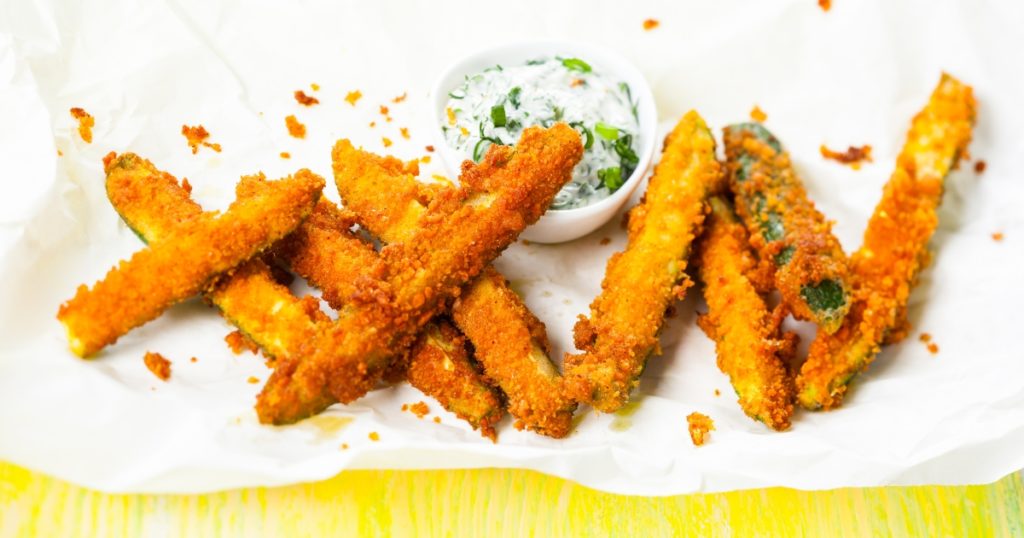
Another good thing about breading is that it helps keep food moist when you deep-fry or pan-fry it. Of course, although breaded food is typically fried (even in an air fryer), you can also bake these foods and get good results.
How To Bread At Home – Things To Prepare
These are what you need to bread foods.
Ingredients:
- Food to be breaded (i.e. chicken cutlets)
- Flour
- Beaten eggs
- Bread crumbs, panko breadcrumbs, crushed crackers, or other types of dry ingredients for the breading
- Optional ingredients are salt and pepper, or parmesan cheese, if you want to have seasoned breadcrumbs
Equipment:
- Three shallow bowls or dishes
- A fork or a whisk
- Food processor, if you plan on making your own bread crumbs
- Tongs to handle the food
- Baking sheet or wire rack (only if you’re breading in advance)
- Deep fryer, pan, or air fryer (for cooking the breaded food)
The first step in breading anything is to prepare the food properly, whether you need to clean it, cut it up, or even season it to your taste. Take note that if you’re breading meat, pound it thin so it gets cooked all over. Ensure also that the food is as dry as possible, as excess moisture will prevent the breading from sticking properly to your food.
Now, remember our blog article about the best kitchen tips for beginners? You have to have your equipment on hand so that the entire procedure goes as smoothly as possible and you don’t get rushed or panicked.
Get your three bowls or dishes. Designate one for flour, one for beaten eggs, and one for your dry ingredient for breading, then fill them up. You’re now ready for the actual breading process.
How To Bread Food: The Three-Step Process
The usual or standard breading procedure is a three-step process. Basically, you first roll the food in some flour. Once the food is completely dredged in flour, you then dip it in beaten egg. Finally, you coat it in bread crumbs.
Do take note that this is a standard procedure. This may not be applicable if, say, you’re looking for steps on how to bread chicken for Chinese food. Got it?
Here’s a more in-depth look at this procedure.
Step 1: Coat the Food in Flour
The first step in the breading process is to coat the food in flour, then make sure to shake off any excess flour. Doing this will help the egg wash adhere to the food. It also creates a barrier between the food and the crumb coating you will make in the next few steps.
Step 2: Dip the Food in Egg Wash
Get your food dredged in flour and then dip it into your beaten egg bowl. This is important to let the dry ingredient of your choice stick to the food and so you’ll get a crispy crust. Make sure the food is fully coated in the egg wash.
Step 3: Coat the Food in Breadcrumbs
Here’s the last step: coating in breadcrumbs! If you’re wondering how to coat food with bread crumbs, the last two steps were the key. If you skipped them, there’s no way the crumbs will stick to your food.
But since you didn’t, you only have to press the crumbs gently on the food’s surface until they stick. And that’s it–you have successfully breaded food!
Can You Bread Food Without Eggs?
You might have an egg allergy, dietary restriction, or ethical reasons, so you can’t have eggs. So can you bread food without using any eggs? The answer is yes.
How to bread food without eggs, you ask? Instead of using beaten eggs, substitute it with an egg wash made with flour and water. It’s thick enough to use as a paste, which you can use in Step 2.
Can You Bread Something Without Flour?
What if you don’t have flour? Well, you can bread something without flour. Instead of dredging the food in flour, use seasoned bread crumbs or panko breadcrumbs.
You can also try using baking powder, baking soda, or simply just pressing the meat over the crumbs until it’s fully coated. Hey, it works!
Tips and Tricks for Perfectly Breaded Food
Here are some things to keep in mind as you dredge and bread:
- If you want a really crispy coating, ensure the ingredients you use for your breading are dry.
- If you want extra crispy breading, re-do steps 1 to 3.
- Designate one hand as your dry hand for the dry ingredients and the other as your wet hand for the wet ingredients to avoid clumping and mess.
- You have many options for dry ingredients for breading. Choose from tempura, nuts, and even cornflakes. Just make sure they will enhance the flavor of what you’re cooking!
- For gluten-free breading (but not keto), you can use gluten-free flour, chickpea flour, coconut flour, cornstarch flour, cornmeal, and many other options in the market.
- If you forgot to buy bread crumbs or dry ingredients and you’re wondering, “Can I use bread as bread crumbs?”, well, you can! Simply place the bread in a food processor and pulse until you get fine crumbs.
Cooking the Breaded Food
Once your food is breaded, it’s time to cook it. The cooking method will depend on the type of food you’re making and the recipe you’re following, but some popular options include frying, baking, and air-frying. Whichever method you choose, be sure to preheat your cooking surface and oil or spray it with non-stick cooking spray.
Here are some tips for better cooking of your breaded food:
- Chilling breaded foods in the fridge before frying or air-frying will help the breading stay on the food. That also means you can bread food in advance. However, also take note that if the breaded food stays too long in the ref, it won’t be that crispy since it will absorb water and get soggy.
- When you’re cooking, keep an eye on your food to prevent it from burning. It will depend on the thickness of the food, but generally, each side should take 2-5 minutes before being cooked. A good sign is if you have achieved a golden-brown color.
- The amount of breading you use will depend on the recipe you’re following, but having more than what you need makes it easier for properly coated food.
- If possible, use a pressure cooker or the sous vide avant-garde method to cook breaded food to help to keep the coating crispy and prevent it from falling off.
- If your cooking method is deep drying, ensure the oil is hot enough before placing the food in the pan so that the coating doesn’t become soggy.
Final Thoughts
Breading is a simple yet effective way to add both flavor and texture to your food. It’s pretty simple to do and can be done on different kinds of food. However you plan to cook the food, just have the correct ingredients and follow the standard breading procedure. Give it a try and enjoy delicious, crispy, crunchy, and perfectly golden brown food every single time!
Want To Try Breading At Home?
Now you might be wondering how to bread something, and you’re looking for more than just making the usual fried foods. Well, we have a suggestion: why not try making corn dogs?
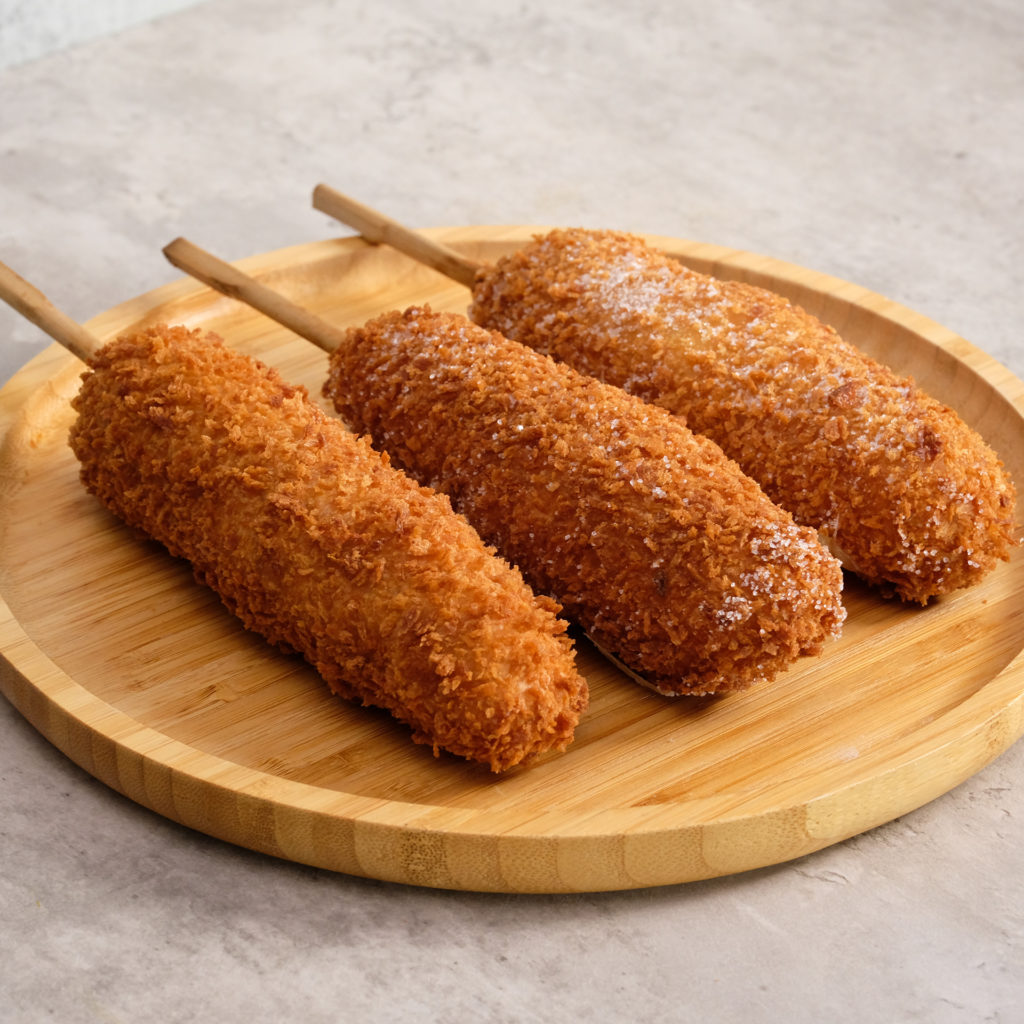
If you’re like plenty of Pinoys who love all things Korean, like K-Pop, K-dramas (historical and otherwise), you’d likely love eating corn dogs too! That’s especially if they keep showing up in your favorite television series.
You won’t have a hard time making them, even if it’s your first attempt to bread anything…that is if you enroll in our latest class with Sir Rodney Martinez: K-Dog Express!
Take this course, and not only will you be able to try out your breading skills, but you’ll also be able to try breading with noodles, chips, and other ingredients! These corn dogs also come in more than one flavor–it’s definitely not going to be boring! And, of course, it helps that you get a bonus recipe for crispy Korean fried chicken, agree?
Plus, if you feel like you’ll have difficulty assembling the food or achieving a crispy coating, don’t worry. Sir Rodney has ensured that you’ll have easy-to-follow instructions in his video and plenty of cooking tips. You won’t need any advanced knife skills or anything like that to achieve delicious results!
Oh, and by the way, corn dogs aren’t popular yet in the Philippines. So why not enroll and be one of the first to make a corn dog food business?
Don’t delay: sign up at The Bailiwick Academy today and start making these fun treats!
—
Keep coming back to The Bailiwick Academy blog for more kitchen tips, tricks, and much more!
]]>He has been hailed as one of the biggest names in the culinary world. Why, you ask? Well, that’s one of the many things you’ll learn about Chef Him in this blog. Keep reading to learn more about this fantastic chef who is part of The Bailiwick Academy!
Who is Chef Him Uy De Baron?
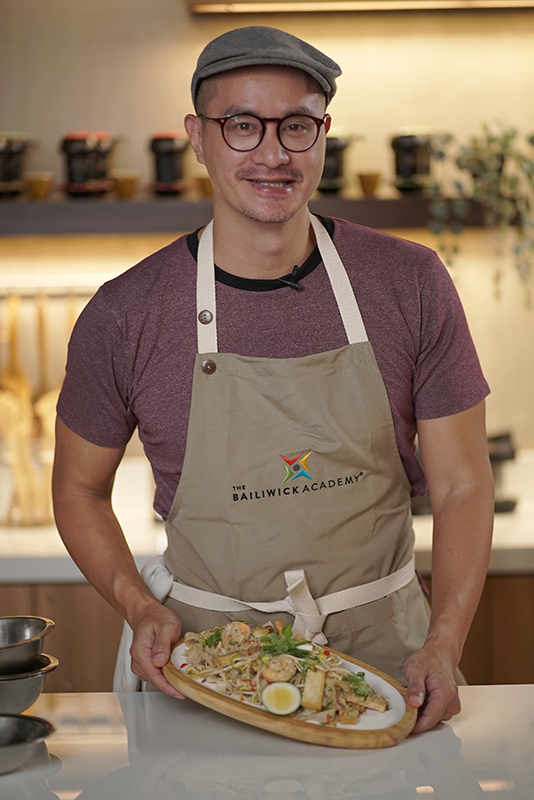
Did you know that Chef Him Uy De Baron has been a chef for over TWENTY YEARS? He started in 2001 and hasn’t slowed down at all. That makes it hard for me to list his many accomplishments, but let’s put some of the more notable ones.
- Chef Him graduated with a Le Cordon Bleu Diplome de Cuisine from Le Cordon Bleu Sydney Culinary Arts Institute.
- He was an executive chef of a catering company called Chef Cuisine.
- Because of his kitchen prowess, he has gone into consulting for companies such as Rustan’s and ABS-CBN.
- He has had multiple restaurants, all with different cuisines, such as Nomama (Japanese), I Am Kim (Korean), Ping-Pong Diplomacy (Chinese/American), and Cocina Peruvia (Peruvian).
- Speaking of ABS-CBN, Chef Him and his team were in charge of the multimedia conglomerate’s food and beverage division.
- Chef Him has been featured countless times in different major media publications such as Philippine Star and Esquire.
Aside from those, he is seen as influential in and out of the industry. For example, he was tapped back in 2014 by a friend to support people in Tacloban after Typhoon Haiyan.
Chef Him also collaborated with Family Mart back in 2015 to make healthy, low-calorie, and vitamin-packed dishes; with Slappy Cakes back in 2016 where he created DIY skillets where diners can choose their meat, sauce and carbs of choice; and recently with Beyond Meat, an L.A.-based brand that makes plant-based meat alternatives for those seeking such options.
See how accomplished he is?
Chef Him: Thankful For Food
Chef Him admits that he wouldn’t be where he is now if it wasn’t for food. You see, years ago, he didn’t know what to do with his life. That was until he encountered food, at least. In fact, he now associates food with plenty of milestones in his life.
For example, according to this Filipino food blog, Chef Him’s love for cooking delicious food was influenced by his mom. He grew up with his mom manning the kitchen, especially for special occasions. He credits those memories as having influenced his own cooking.
And as a chef, you can bet that he has plenty more unforgettable memories, and that’s all because of food.
What is his cooking style?
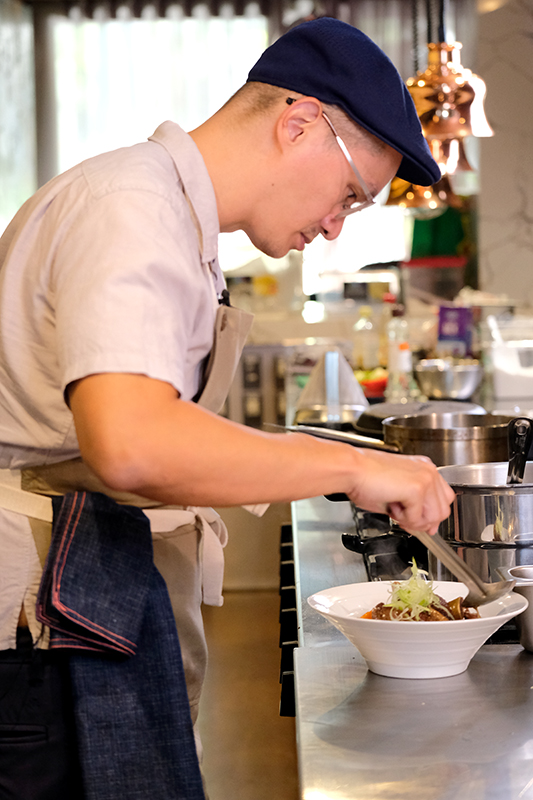
As mentioned earlier, Chef Him can make delicious dishes, whether Filipino, Thai, Japanese, Korean, Peruvian, or even street-style hawker fare. You can describe Chef Him as a cooking chameleon.
And it’s not just that he’s great with different cuisines. Chef Him is also known for creating vibrant flavors and his meticulous attention to detail just to make sumptuous meals. And if you’re wondering about how he developed his unique cooking style, he credits it to his curiosity back when he was still a child.
Every time he ate something, he would always wonder about the ingredients in the food. He would then attempt to replicate it when cooking. And, of course, the more he tasted as he grew older, the more his palate became sensitive–and the more attempts he made to put delicious tastes together.
That’s why even if he has learned to make different cuisines, Chef Him is not necessarily striving for authenticity. For Him, what’s more important is to borrow and combine different techniques and flavors of different cuisines that work well. For example, he has already tried developing a ramen recipe that wasn’t traditional at all: think of it as getting the best of Southeast Asian flavors and textures and mixing it in with Japanese fundamentals.
His various restaurants are also examples of this philosophy that he has.
Chef Him During The Pandemic: Heartbroken
Despite all the successes Chef Him had, one major setback he experienced was back in 2020. He had been contacted by ABS-CBN, and Chef Him had been gearing for big things to start the year. Sadly, the COVID-19 pandemic hit, which also meant a long lockdown in the country.
That meant all that they were planning had to be stopped. And pretty soon, he and his team lost their job running the food scene in ABS-CBN.
How Him Bounced Back
Chef Him is a lot of things, but he is not one to sit on laurels and mope. One of the things he believes in is to always adapt to the times. And he realized that people were getting tired of always cooking the same thing or ordering out during the pandemic.
So Chef Him thought to teach his recipes to people looking for more enjoyment out of their food. And The Bailiwick Academy became one of his avenues to teach people how to make flavorful dishes!
How is Chef Him Uy De Baron as a teacher?
Joining TBA isn’t exactly Chef Him’s first foray into teaching. After returning from Australia in 2001, he started teaching at a culinary school and appeared in other schools. He calls himself an accidental teacher, but in this field, he finds fulfillment by nurturing students and sharing what he knows. Chef Him actually feels mightily rewarded when he sees his students using what he has taught.
Now, one impression of Chef Him the first time you see him is that he’s a very strict taskmaster.
But you’d be surprised how much fun he is to be with–check out this behind-the-scenes video during a recent shoot of one of his lessons.
One thing you can be sure about Chef Him is that if there’s anything he’s serious about, it’s developing the skills of his students–and making sure that he has recipes that will really tickle your taste buds. He’s a really hands-on instructor, too!
And based on some testimonies from his students at TBA, he’s been very successful. Check out what Adam had to say:
Maria agrees:
And so does Marilyn!
In other words, those who go under Chef Him’s tutelage can be sure that they will really level up their cooking skills.
What’s next for Chef Him Uy De Baron?
Chef Him always believes in new opportunities in the food and beverage industry. That’s why he’s always looking for new ways to spread his culinary skill. Chef Him is a risk-taker too.
As he said in an interview with Esquire:
“If I think of putting everything in a business perspective, I might not have opened the restaurants I have opened. For me, if I feel that it is a really great idea, I go, ‘screw it, lets do it!’ “
You never know, you might hear of him opening a new restaurant soon!
Oh, and of course, new Chef Him classes are already lined up at The Bailiwick Academy! Just wait for us to release them. In the meantime, check out his classes that are already available:
Celebration Trays – great for leveling up your party fare.
Taste of Thai – experience one of the most popular cuisines in the world from the comfort of your home.
Flavors of India – taste a whole new palette of flavors and textures and demystify Indian cooking.
Dampa Seafood Feast – enjoy delicious seafood bursting with flavors that is Chef Him’s signature touch!
Hawker-Style Specials – have a different kind of street food experience with Singapore’s flavors.
Make sure to sign up at The Bailiwick Academy to access Chef Him’s delicious recipes today!
Final Thoughts
I’m going to leave you with what Chef Him thinks is important to truly become a great chef. The first is skill. You can’t become a great chef overnight–you really have to practice constantly and have the determination to have skill.
The second is to develop your taste. You can go to school to become a great chef, but taste is not something you can learn. It’s personal, something accumulated through the years.
And as a person becomes more experienced in cooking, they have to go from simply enjoying the taste of food to actually understanding how it was created. By honing their technique and experimenting with ingredients, a chef can develop a unique and personal style that sets them apart in the culinary world.
Such powerful and inspiring thoughts, agree?
Make sure to enroll in Chef Him Uy De Baron’s classes to get more nuggets of wisdom like these!
—
Keep coming back to The Bailiwick Academy blog for more kitchen tips, tricks, and much more!
]]>Well, not to worry. Chicken is very versatile, meaning you can make a bunch of dishes with it. Check out these suggestions from The Bailiwick Academy!
How to prepare and cook a whole chicken: Chinese-style!
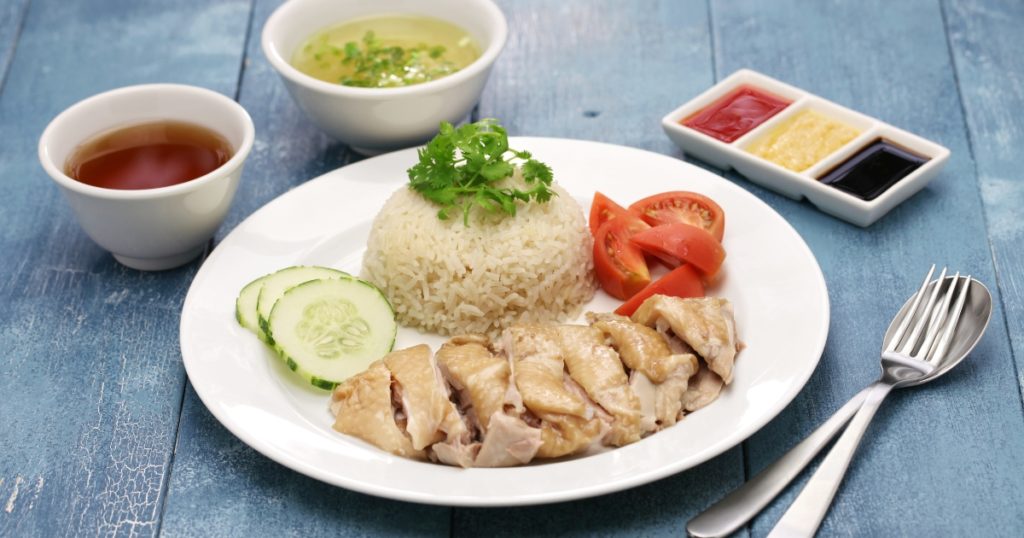
Pinoys love Chinese food because it has been part of our culture for over a hundred years. So if you’re going to add anything to your Christmas menu that’s chicken, why not refer to some Chinese recipes?
There are actually three you can look at: Soy Chicken, Hainanese Chicken, and their version of a roast chicken recipe. All three are sure crowd pleasers and will definitely satisfy hungry tummies.
Learn the recipes for those at our Authentic Chinese Roasting class!
Tinola
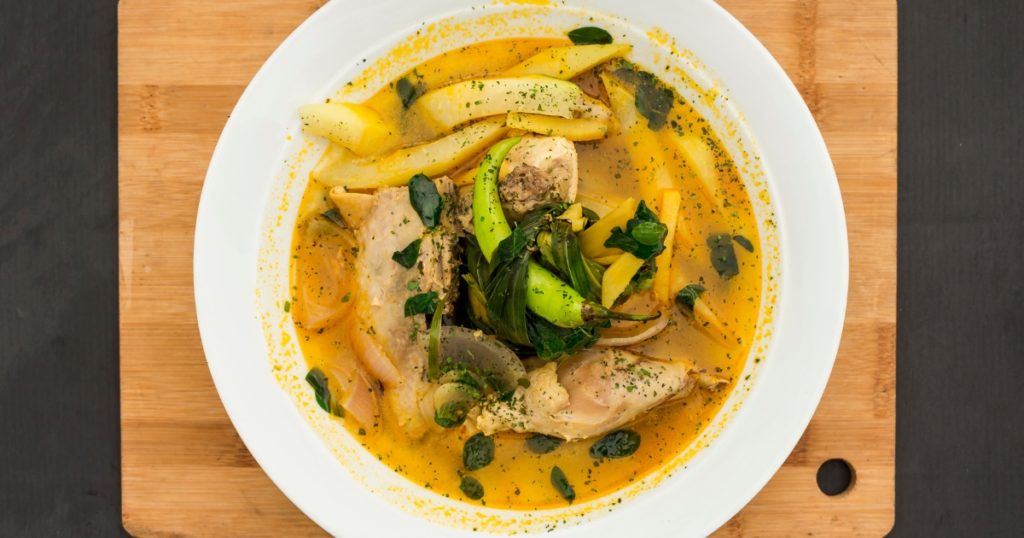
If you’re looking for a whole chicken to go with soup recipes, tinola is one you shouldn’t miss out on. It’s a popular chicken recipe here in the Philippines where the chicken is boil in broth with vegetables such as gabi and sayote, and flavored with ginger.
The soup is also flavorful and soothing and is perfect for the more chilly weather this December.
How do I cook a raw whole chicken? Just bake it!
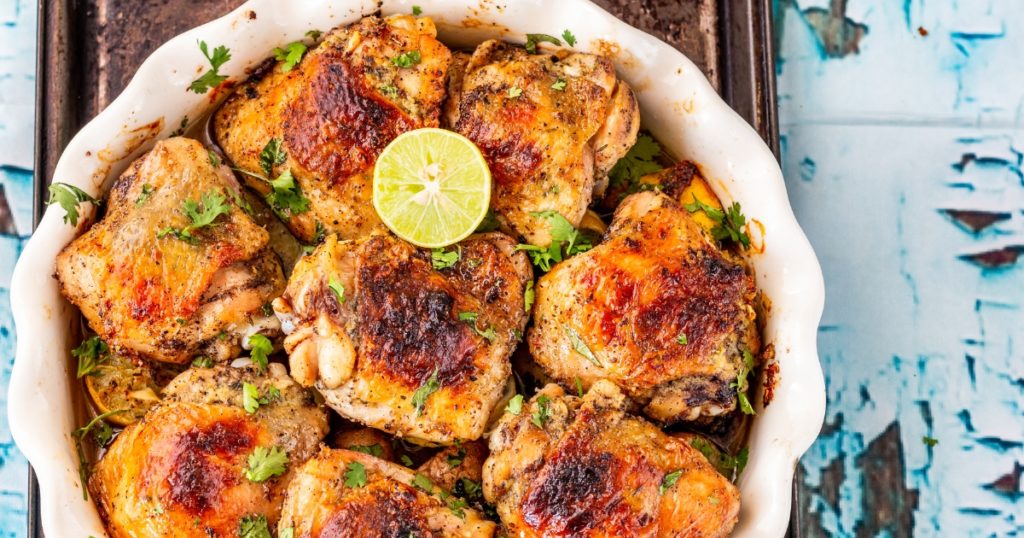
So contrary to popular belief, you don’t need a rotisserie machine to get started on baking chicken. How do you cook a whole chicken in the oven, exactly?
Well, there are actually plenty of recipes out there, but it’s not rocket science, to be honest. All you need is some salt and pepper, olive oil or butter, and your desired herbs and spices. Season the chicken, pop it into your oven and cook depending on your recipe of choice.
You’ll end up with some delicious baked whole chicken that everyone will be dying to get their hands on!
Adobo
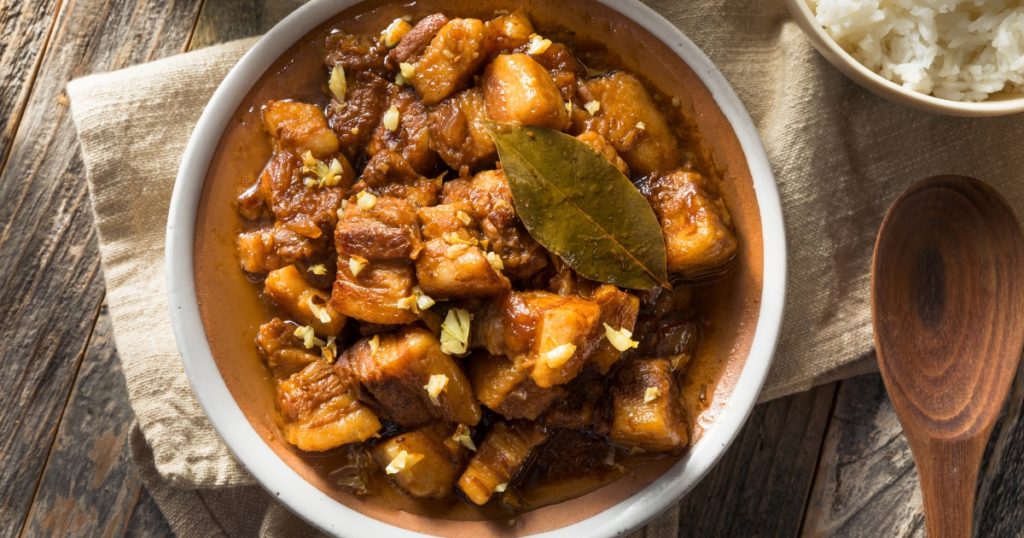
Here’s another basic thing you can do with your whole chicken: adobo! It’s a well-known Filipino chicken recipe that we’re sure all Filipinos know about. Even foreign celebrities love it!
And here’s the fun part: how you make it will vary depending on where you got your recipe from in the Philippines. Sure, it has soy sauce and garlic as the main ingredients, but you can make it mildly spicy or very spicy depending on your preference.
Personally, we’d prefer that added kick for more variety and festivity come noche buena!
Oh and if you don’t get to finish it during dinner, at least you can be sure it won’t spoil – that means plenty of leftovers!
Pininyahang Manok
If you were asked “How to make a good whole chicken?”, one of the last things that would enter your mind would be something that involved pineapples, right? But hey, let’s get real: we Filipinos love the combination of sweet and salty in our food!
And one dish that definitely highlights this is the pininyahang manok, or pineapple chicken as a rough translation. Aside from the obvious ingredients, this stew also has carrots, bell peppers, and sometimes potatoes. You’ll get a rich and savory broth when you add milk and fish sauce.
It’s definitely something special in our opinion!
How to prepare and cook a whole chicken: Chicken inasal!
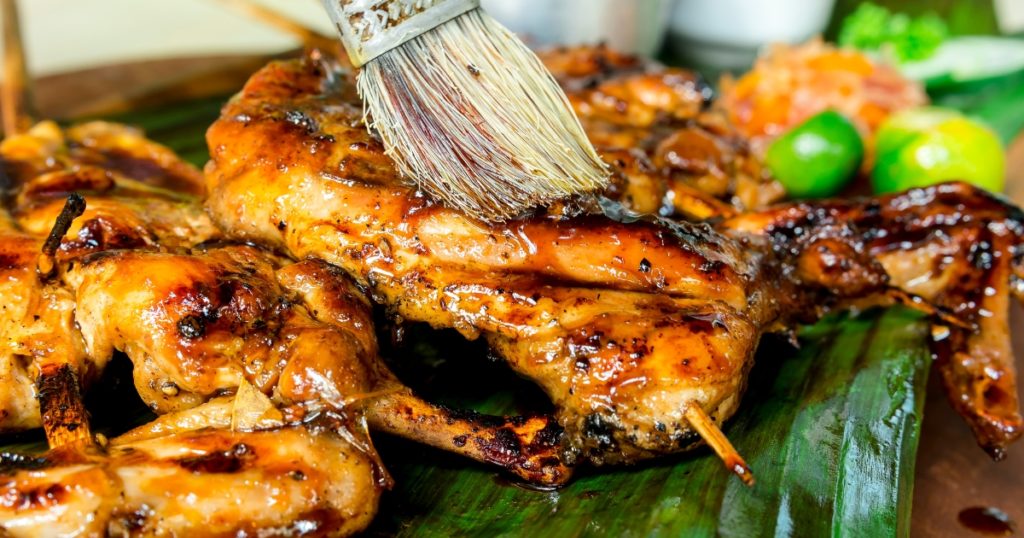
Chicken inasal simply means grilled chicken. Get your whole chicken, chop it up, marinate the parts with a mixture of calamansi, garlic, coconut vinegar, and annatto, and grill over hot coals. It’s actually a pretty common street food in the Philippines, and very popular too. After all, we have plenty of restaurants who serve this as their main offering!
But why bother going over to restaurants when you can just make your own at home, right? Plus, the grilling process outside lends to a more festive experience where your visitors can watch and salivate as you do your cooking. Think of barbecues in the United States, but with our local taste, right?
Arroz con Pollo
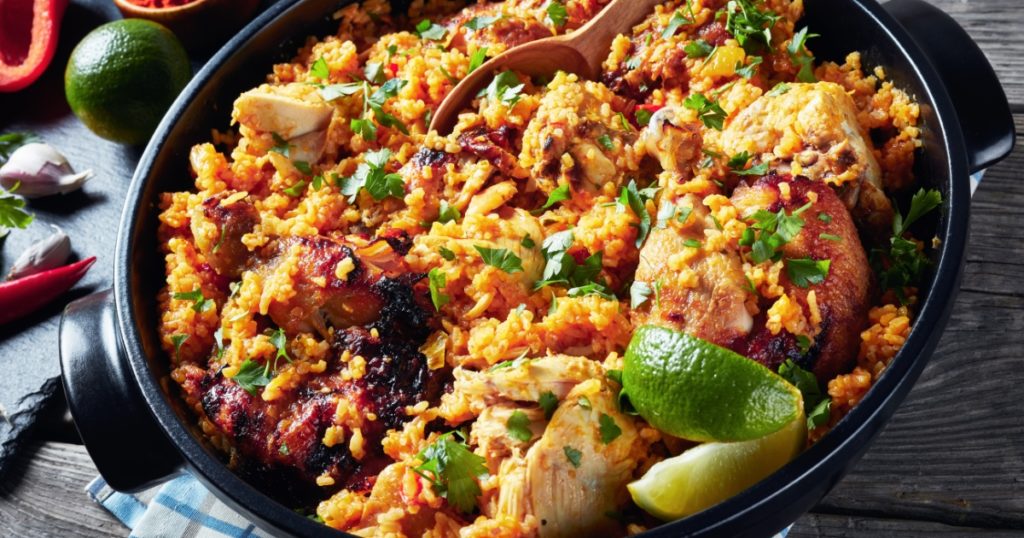
We’ve talked about Arroz con Pollo before in this blog, so isn’t it nice that we’re talking about this delicious chicken dish again? It’s basically rice with chicken and is a popular Latin-American dish. What’s not basic about it is that it has many variations depending on who makes it.
Just like we mentioned before, the basic ingredients of this dish, aside from rice and chicken, are saffron, dry white wine, bay leaf, onions, garlic, bell pepper, chicken stock, olive oil, salt, and pepper to taste.
Some recipes call for additional vegetables, herbs, spices, and even tomato sauce.
This cooked chicken is flavorful because it combines the juiciness of the chicken, the flavors of the herbs and spices, and the rice cooked in chicken stock and other mouth-watering ingredients. Yum!
And if you’re into this particular dish, check out Chef Joey Prats’ version here: Arroz con Pollo y Chorizo! With the addition of chorizo and other ingredients using Chef Joey’s personal recipe, it’s guaranteed to make you and everyone else scream for more!
Malaysian-Style Chicken Curry
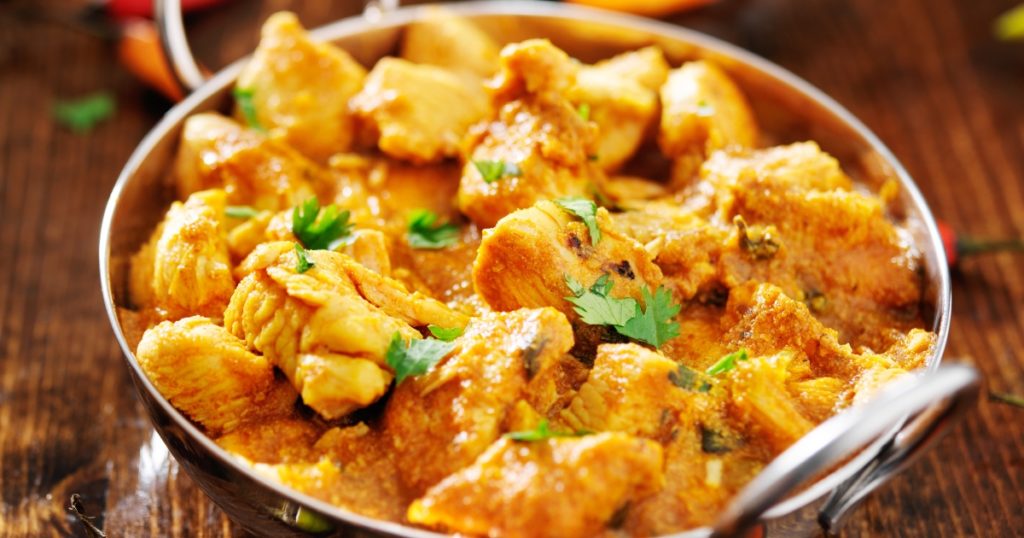
If you’re good with the idea of having Chinese food during Christmas, why not try one with a Southeast Asian flavor? Malaysian-style chicken curry is a tasty and aromatic dish with spices, coconut milk, and potatoes that compose a delicious sauce. Eat with rice or bread for full enjoyment!
Or even better? Eat it with nasi lemak, fragrant rice cooked in coconut milk and pandan leaves. No need to go to Malaysia for this too: just enroll in Chef Him Uy De Baron’s Hawker-Style Specials class!
How to prepare and cook a whole chicken: with ginisang sayote!
Just because it’s the holidays doesn’t mean we should give up on vegetables, right? Ginisang sayote with chicken is an easy-to-prepare dish that is made by cooking diced sayote and chicken and using tomatoes and oyster sauce for added flavoring. This flavorful and nutritious vegetable dish is great with rice, and will help keep you healthy during the holiday season.
Creamy mushroom chicken
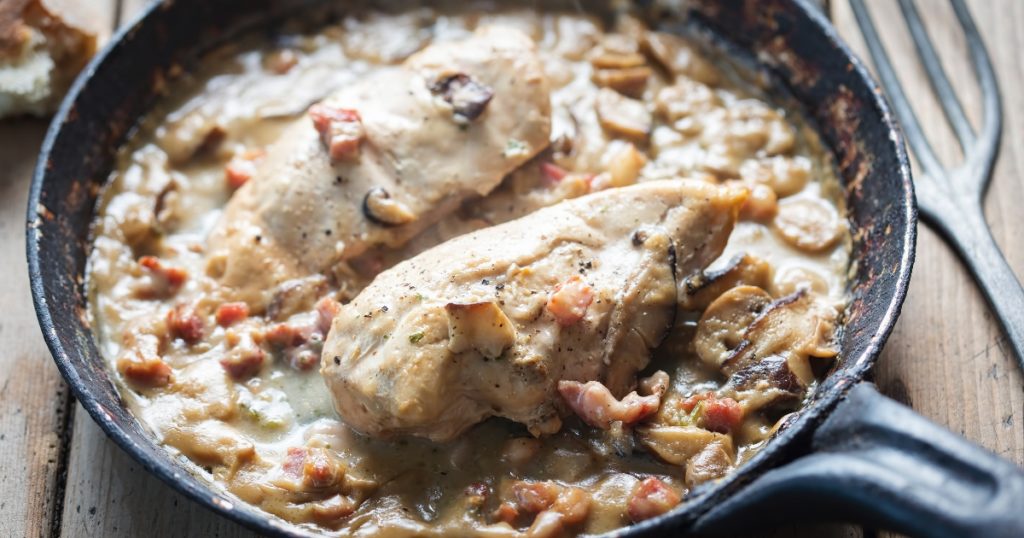
If you want to make a chicken dish that’s not only delicious but is sure to please everyone, make a creamy mushroom chicken dish. It’s composed of tender chunks of chicken, all-purpose cream, and tasty mushrooms. Add some garlic for extra depth and flavor and you get a true culinary masterpiece!
It’s great for serving with wine, too – which means it’s great for eating with a nightcap this Christmas season.
Speaking of how to prepare and cook a whole chicken…
There’s one more dish we forgot to mention on this list – and it’s probably one of the best things you can do with a whole chicken this holiday season!
Have you heard of chicken galantina?
It’s a chicken dish stuffed with many tasty fillings. It’s also been enjoyed by many generations of Pinoys for Christmas and other special occasions. And while it’s super delicious, it can be quite challenging to make.
Well, The Bailiwick Academy has your back with Chef Max Nadin and his latest class: Chicken Galantina!
Enroll in this class and the question “How do you cook a whole deboned chicken” will be answered! You’ll be guided not just in deboning and seasoning the chicken but also making the tasty filling, and roasting everything to perfection. You’ll also learn to make two delicious sauces, and bonus recipes and instructions for a summer salad, crunchy pickled vegetables, and a rice dish!
In short, you’ll get everything you need for a delicious and festive and iconic whole chicken dinner for Christmas! Plus, you can add this to your food business for 2023. After all, New Year IS coming up… as well as many other special occasions!
So what are you waiting for? Create a winner chicken dinner today! Sign up at The Bailiwick Academy!
—
Keep coming back to The Bailiwick Academy blog for more kitchen tips, tricks, and much more!
]]>
 다들 즐거운 주말 보내요ฅ^•ﻌ•^ฅ
다들 즐거운 주말 보내요ฅ^•ﻌ•^ฅ  스테파니킴치 –
스테파니킴치 –